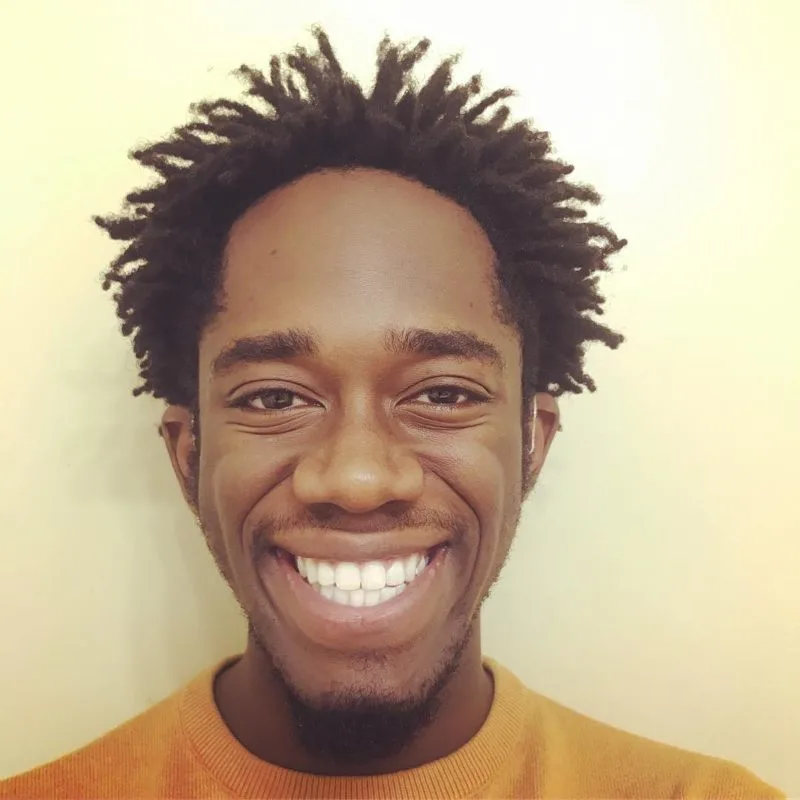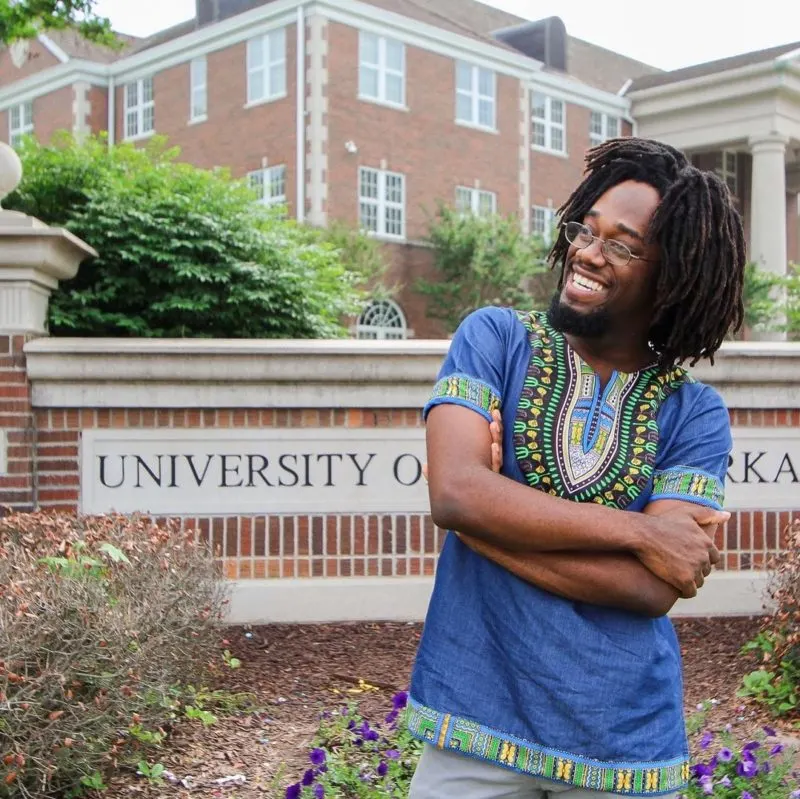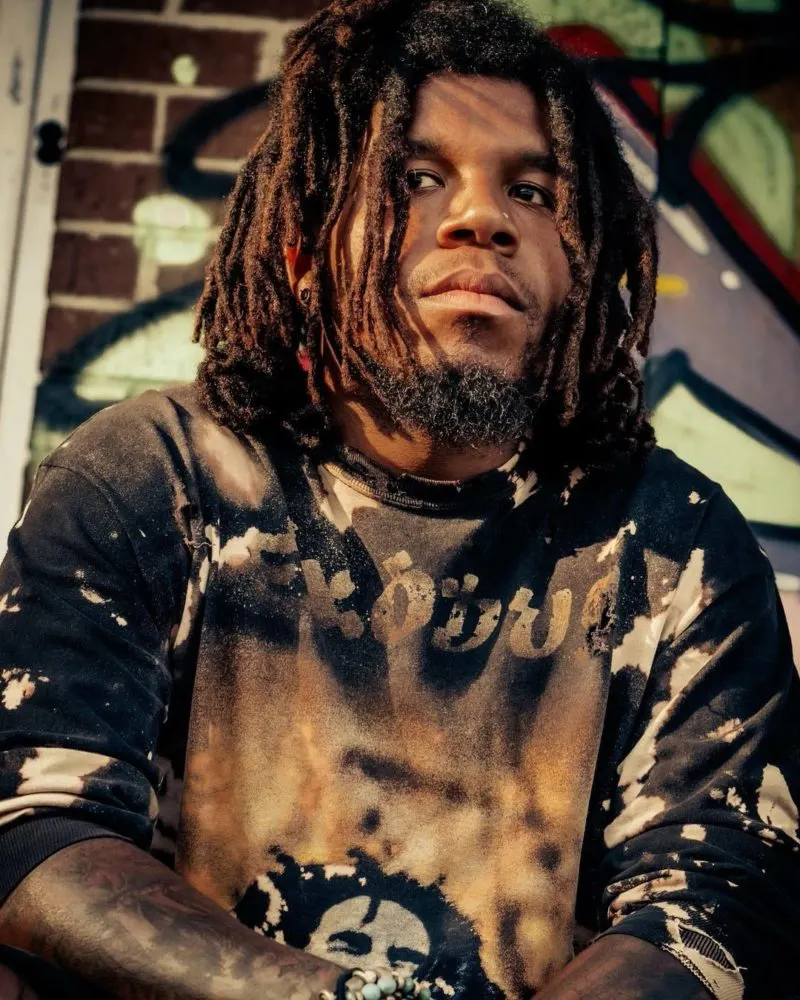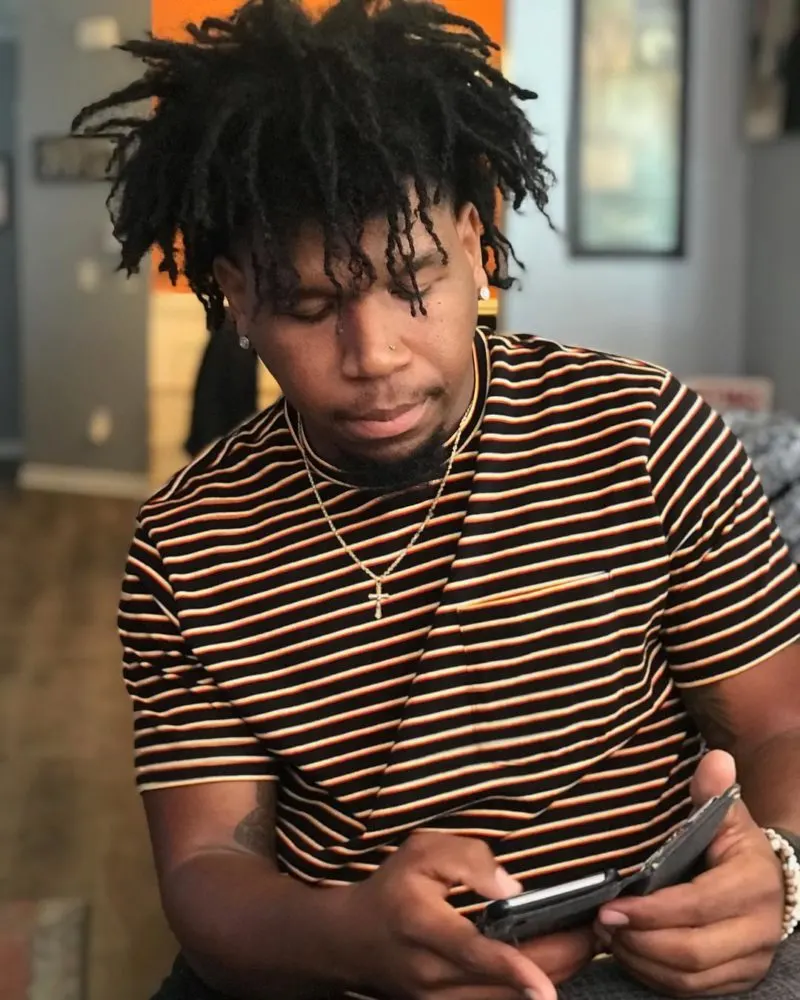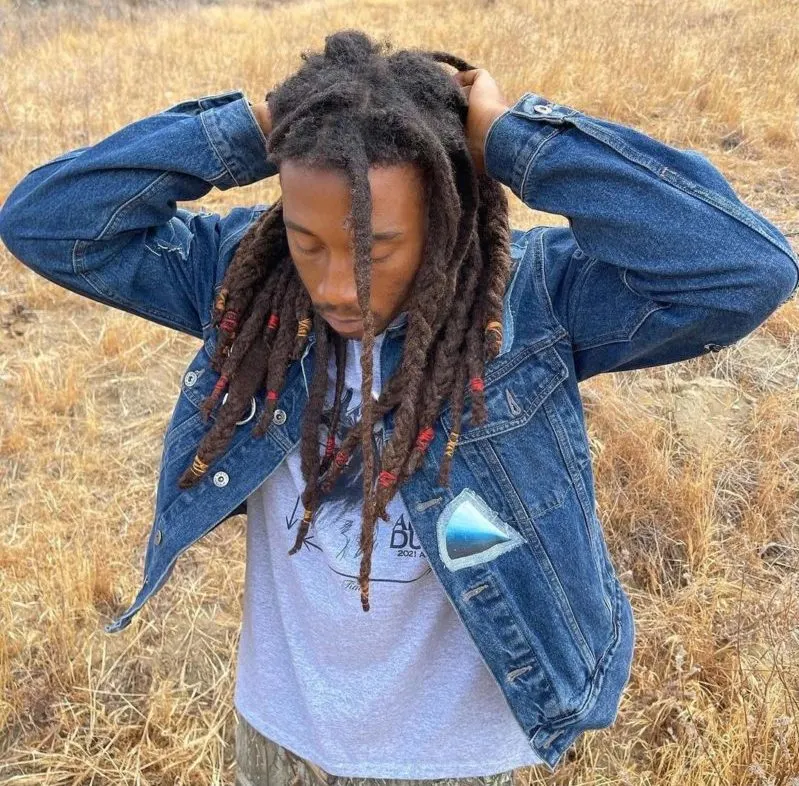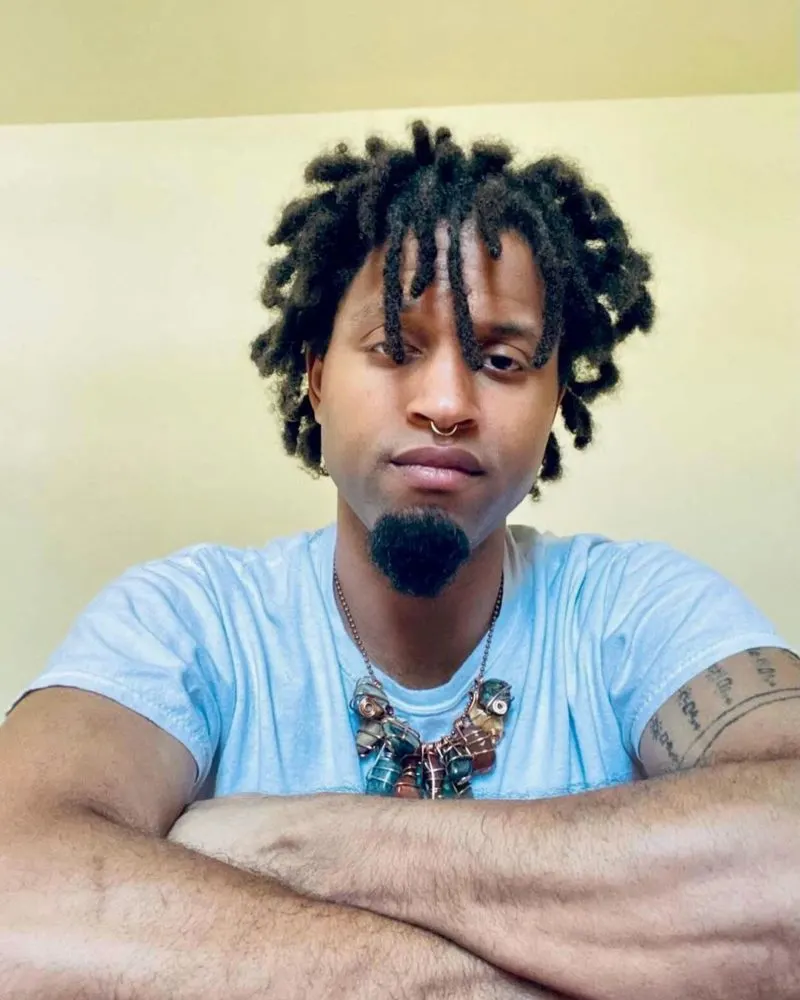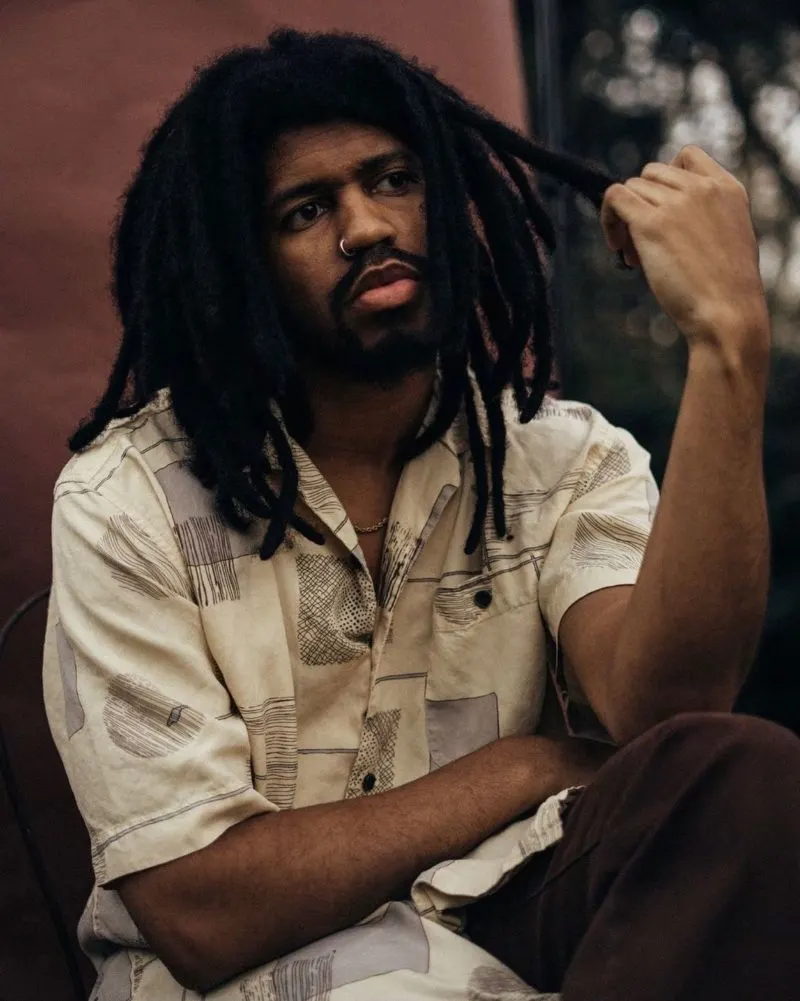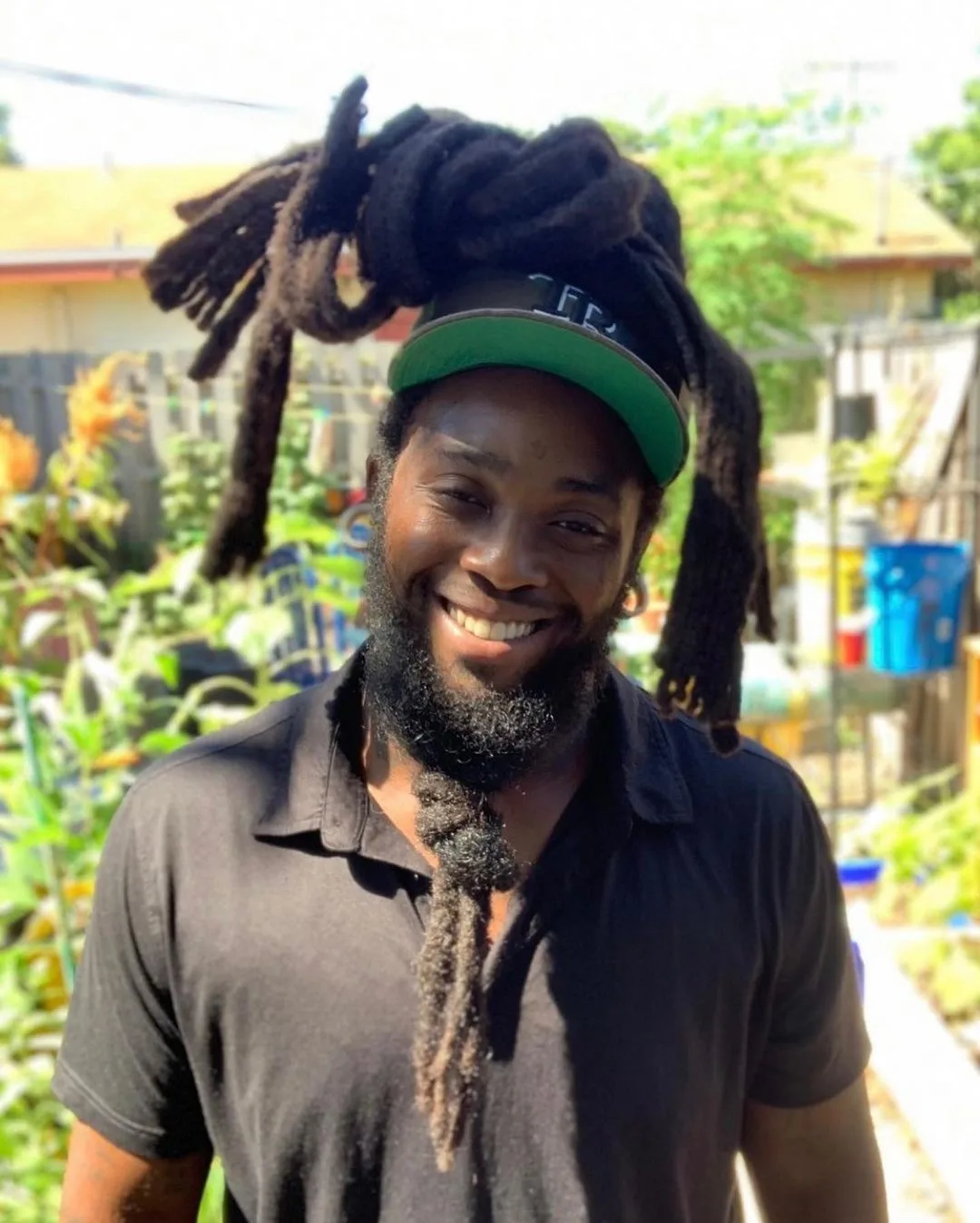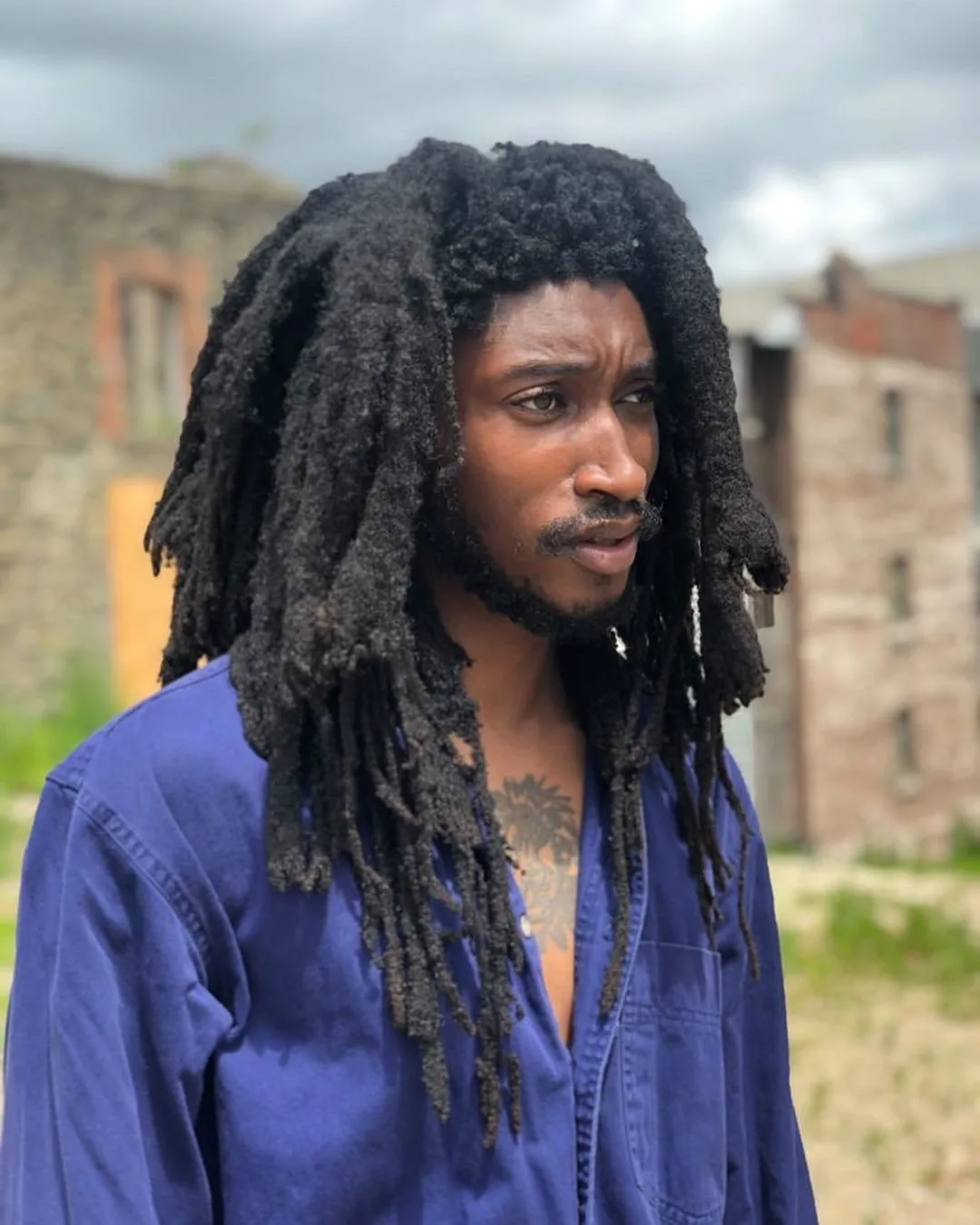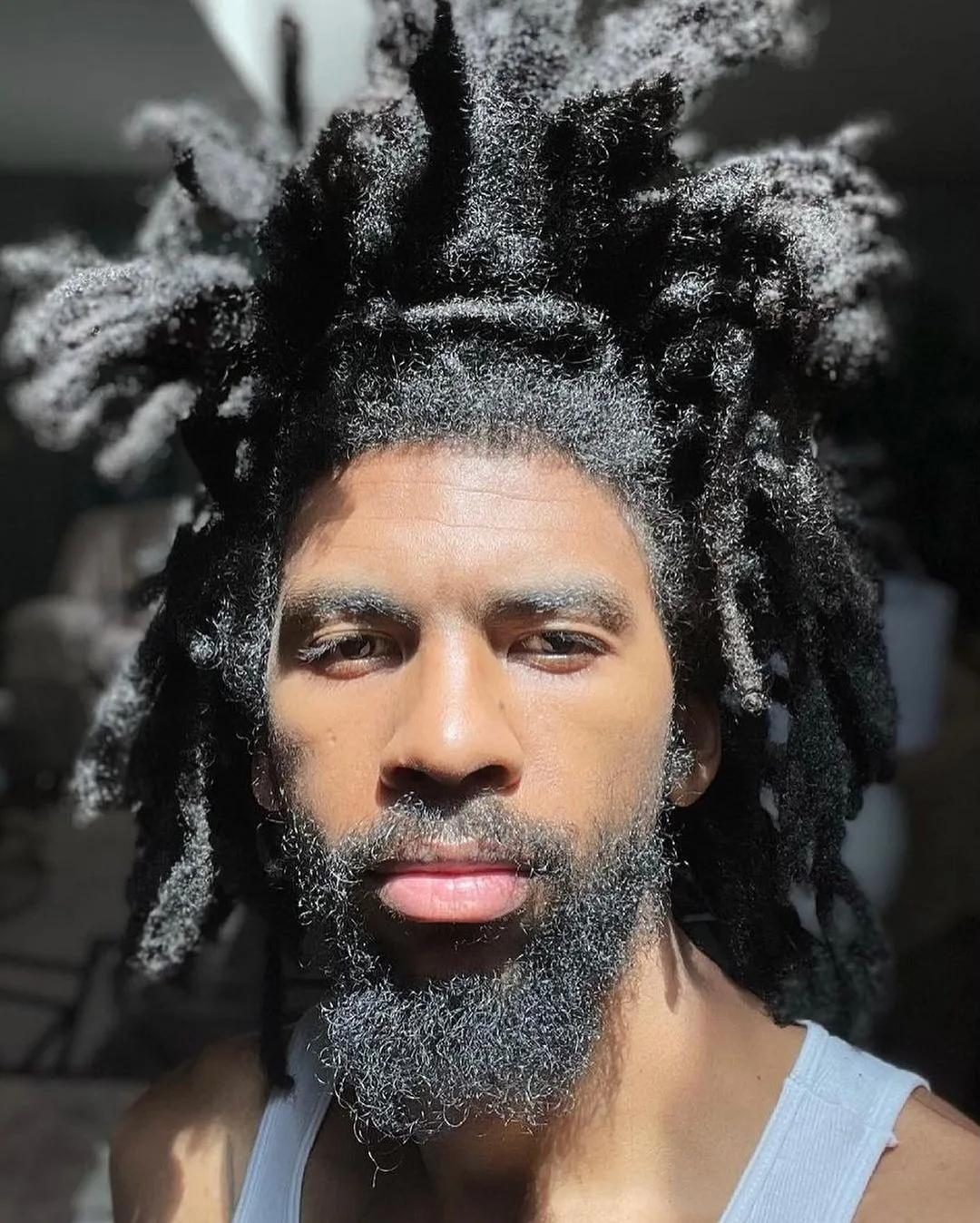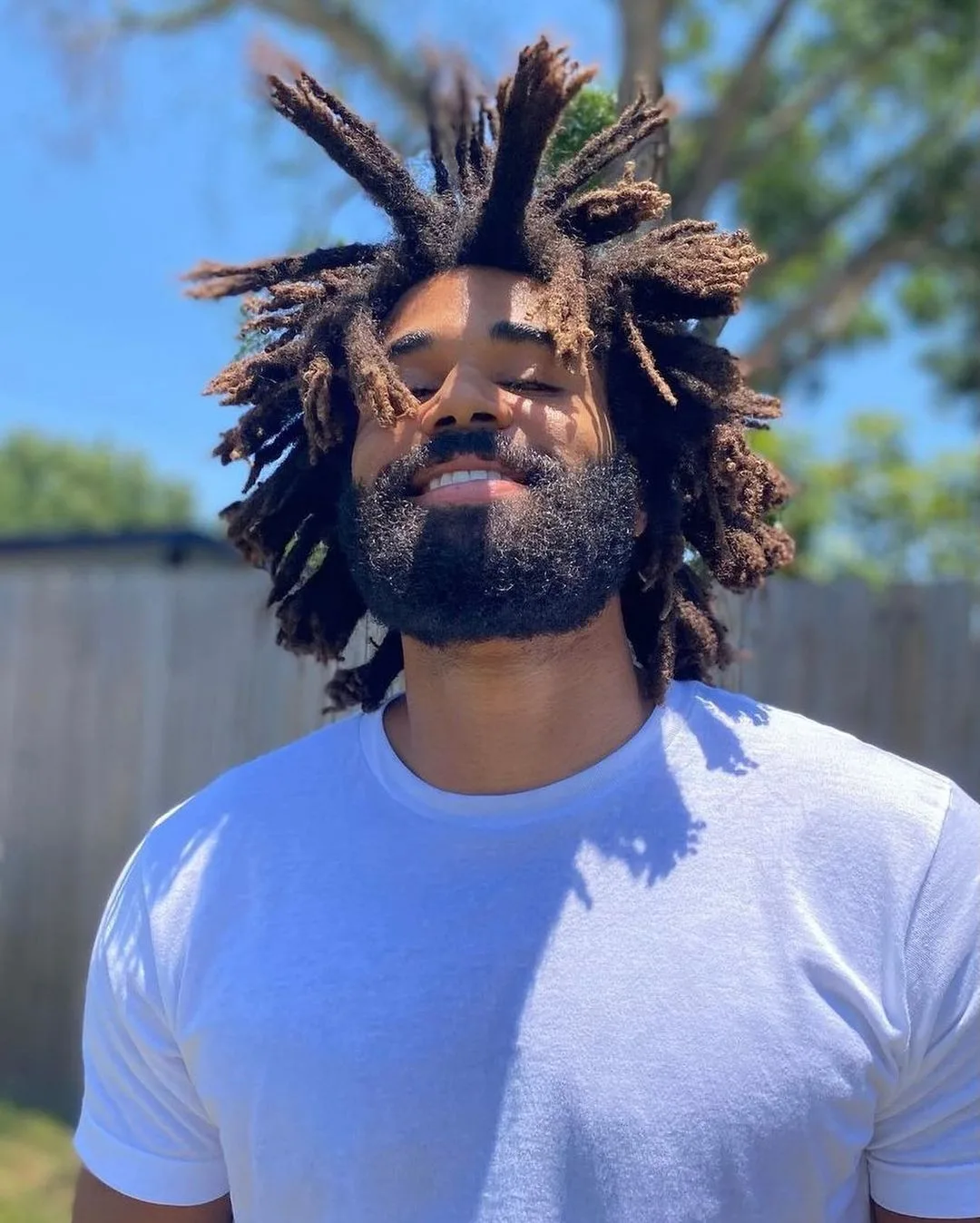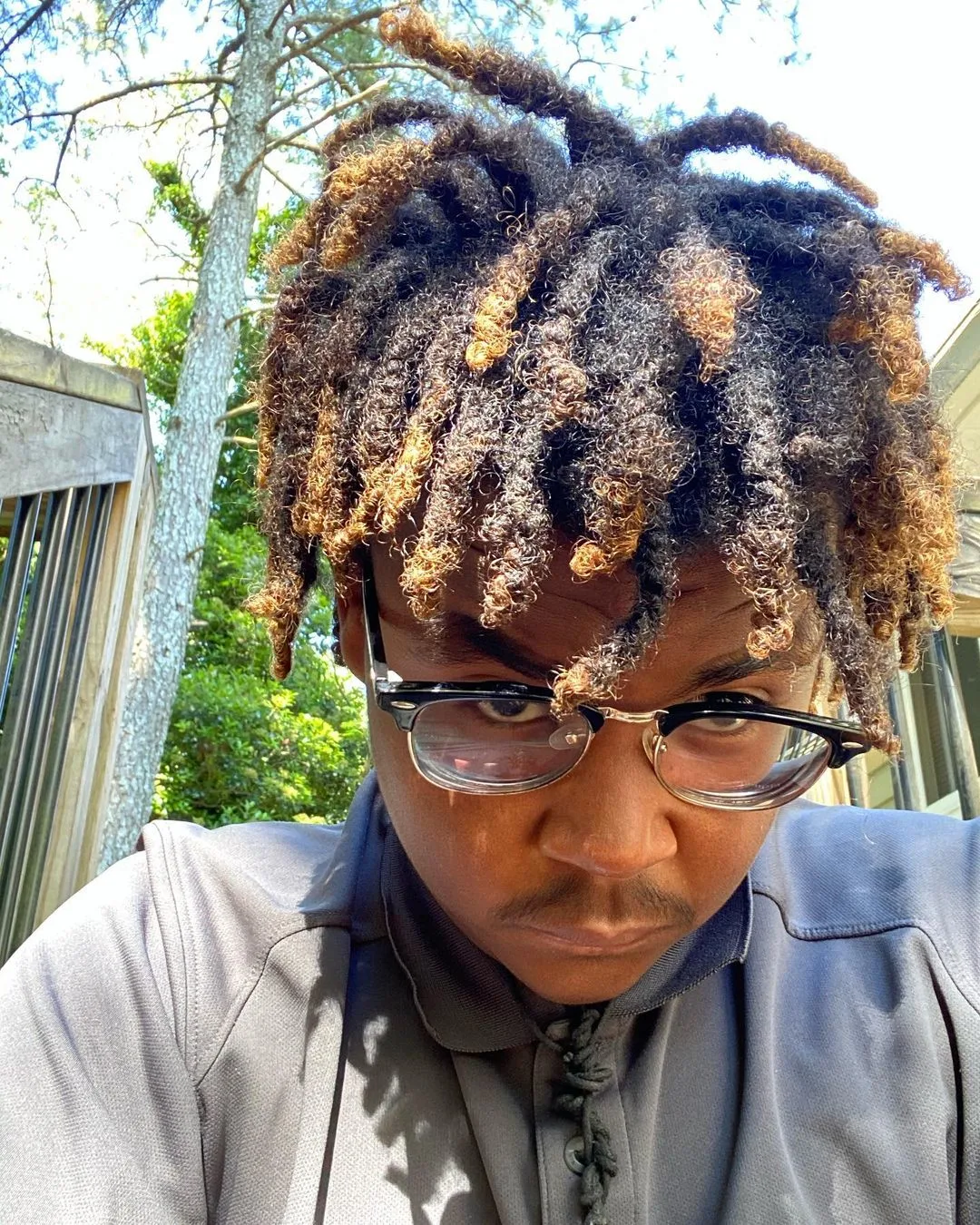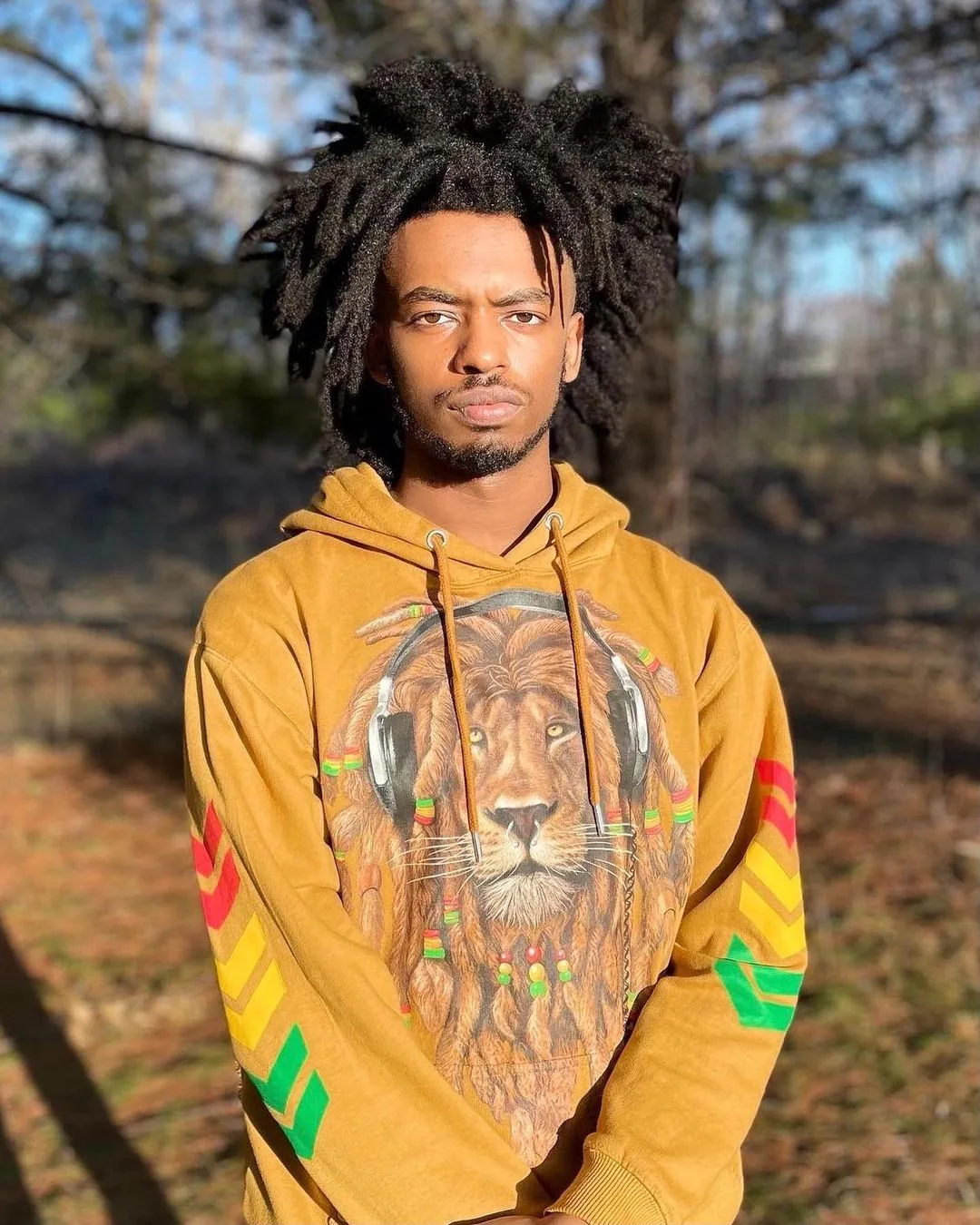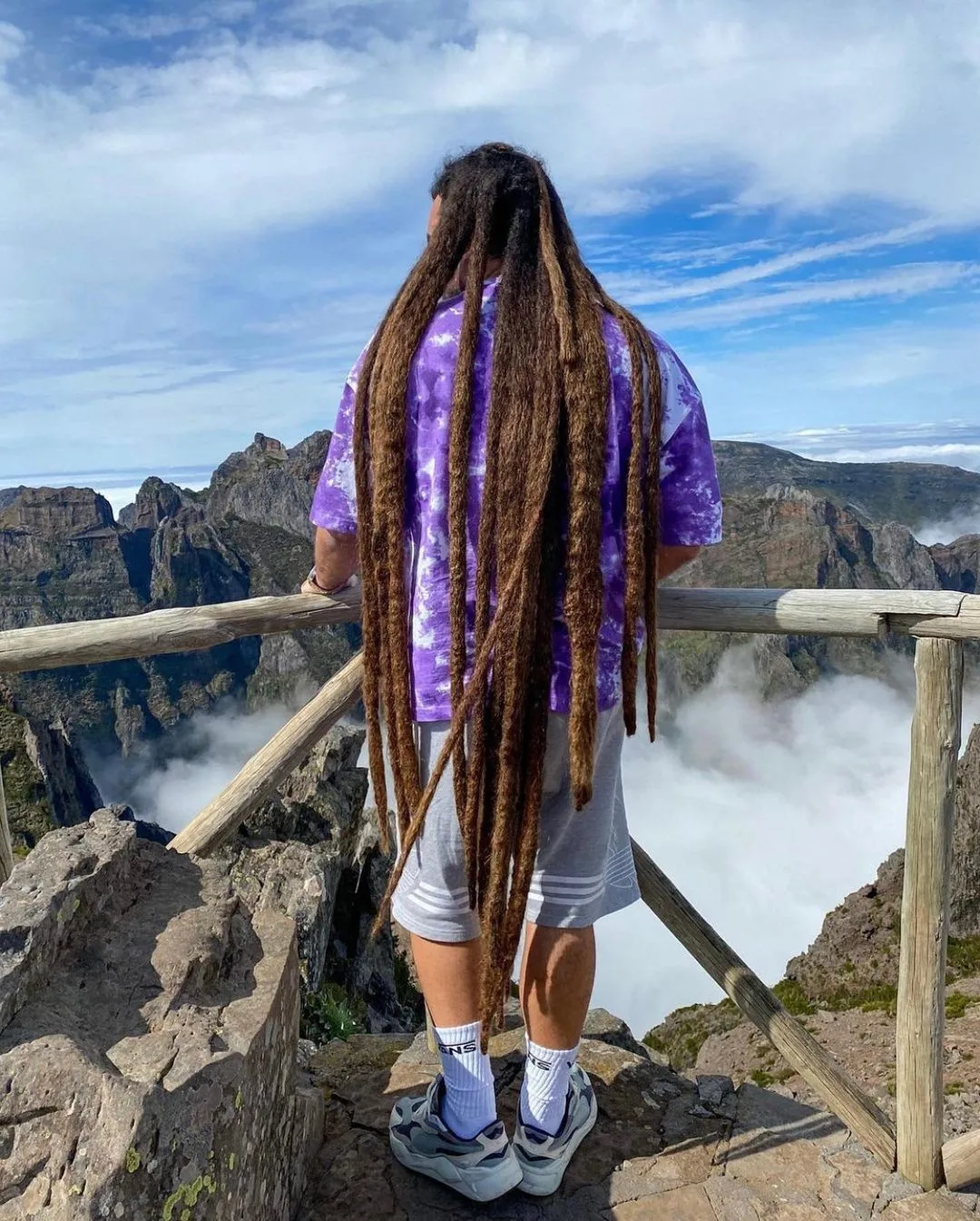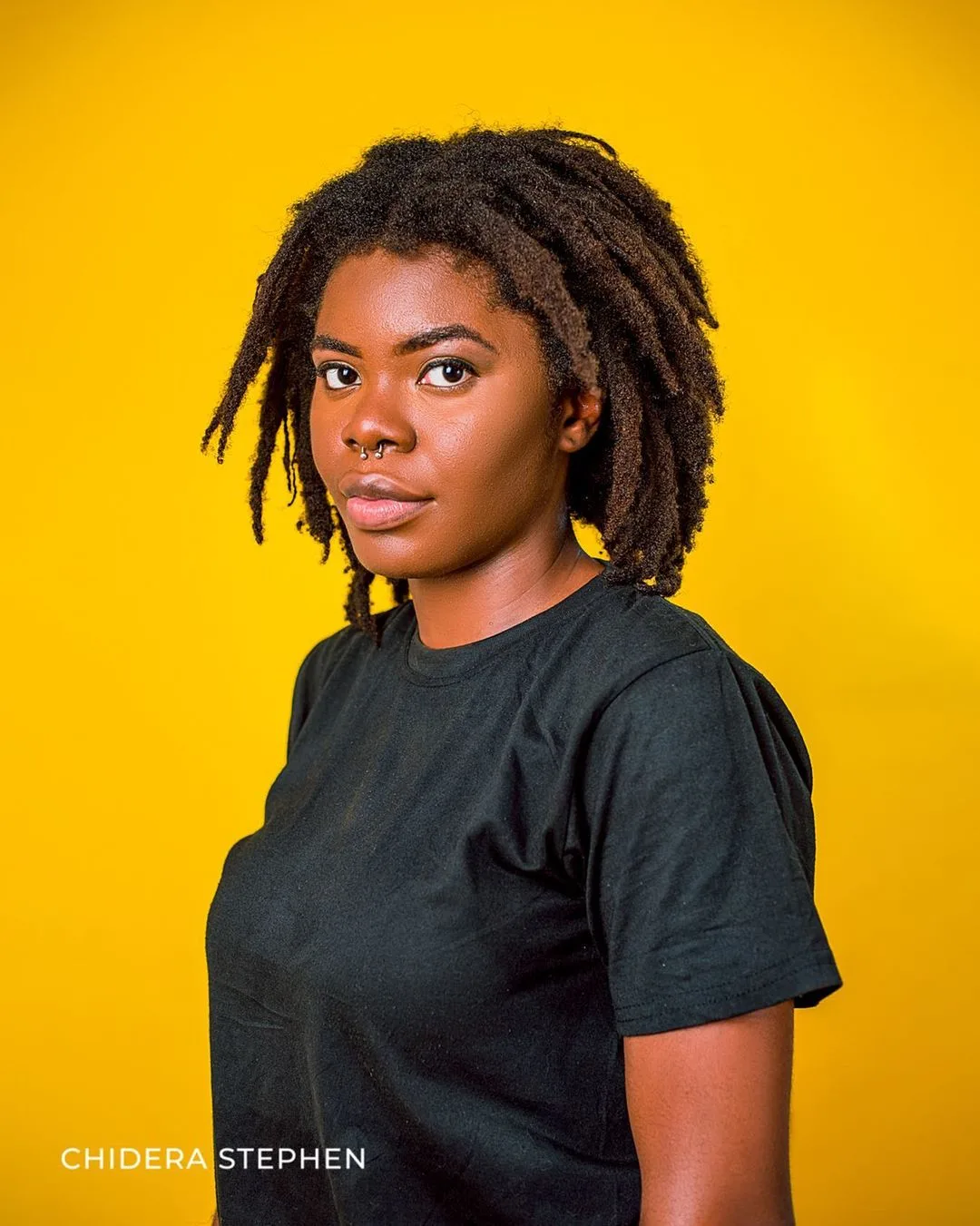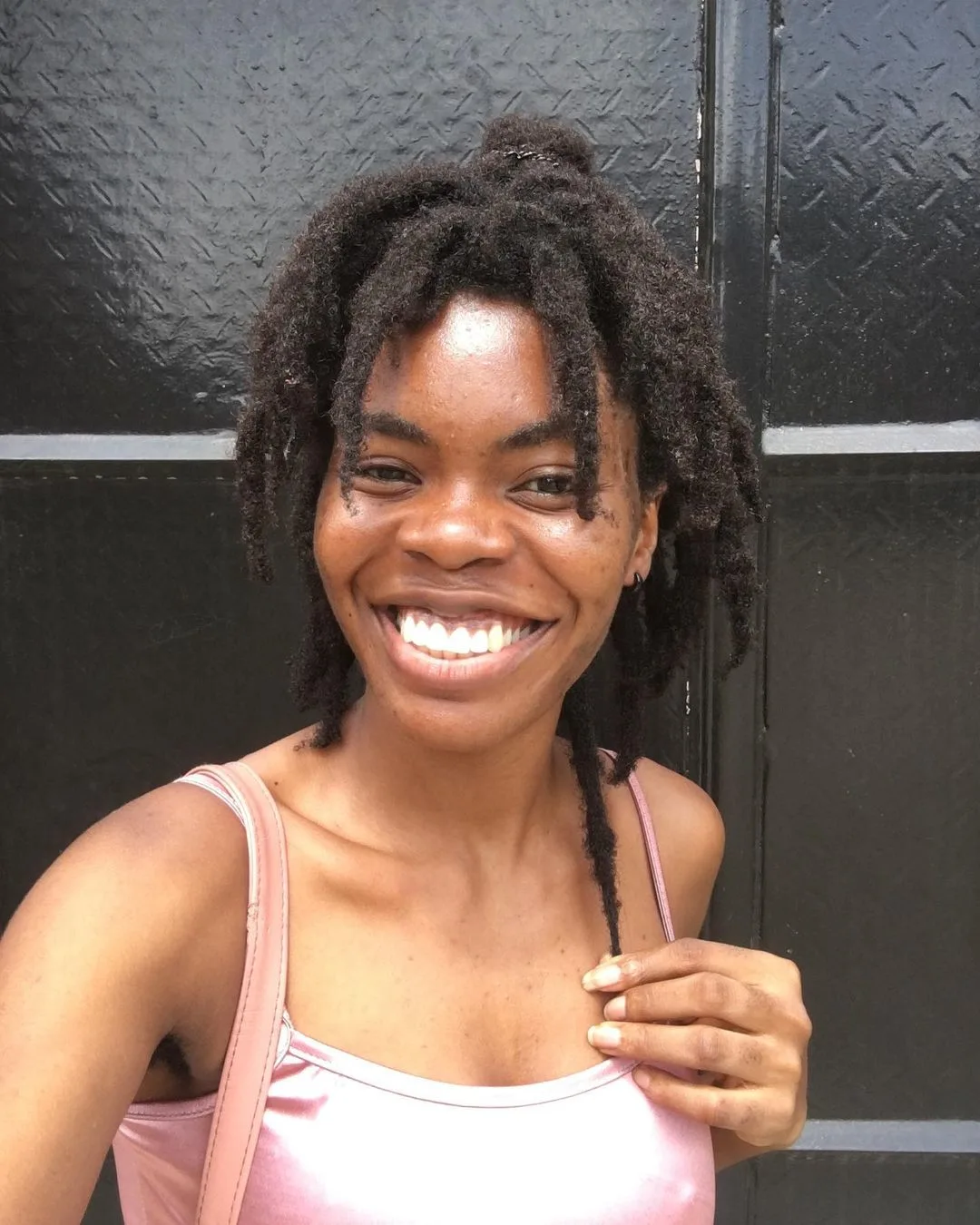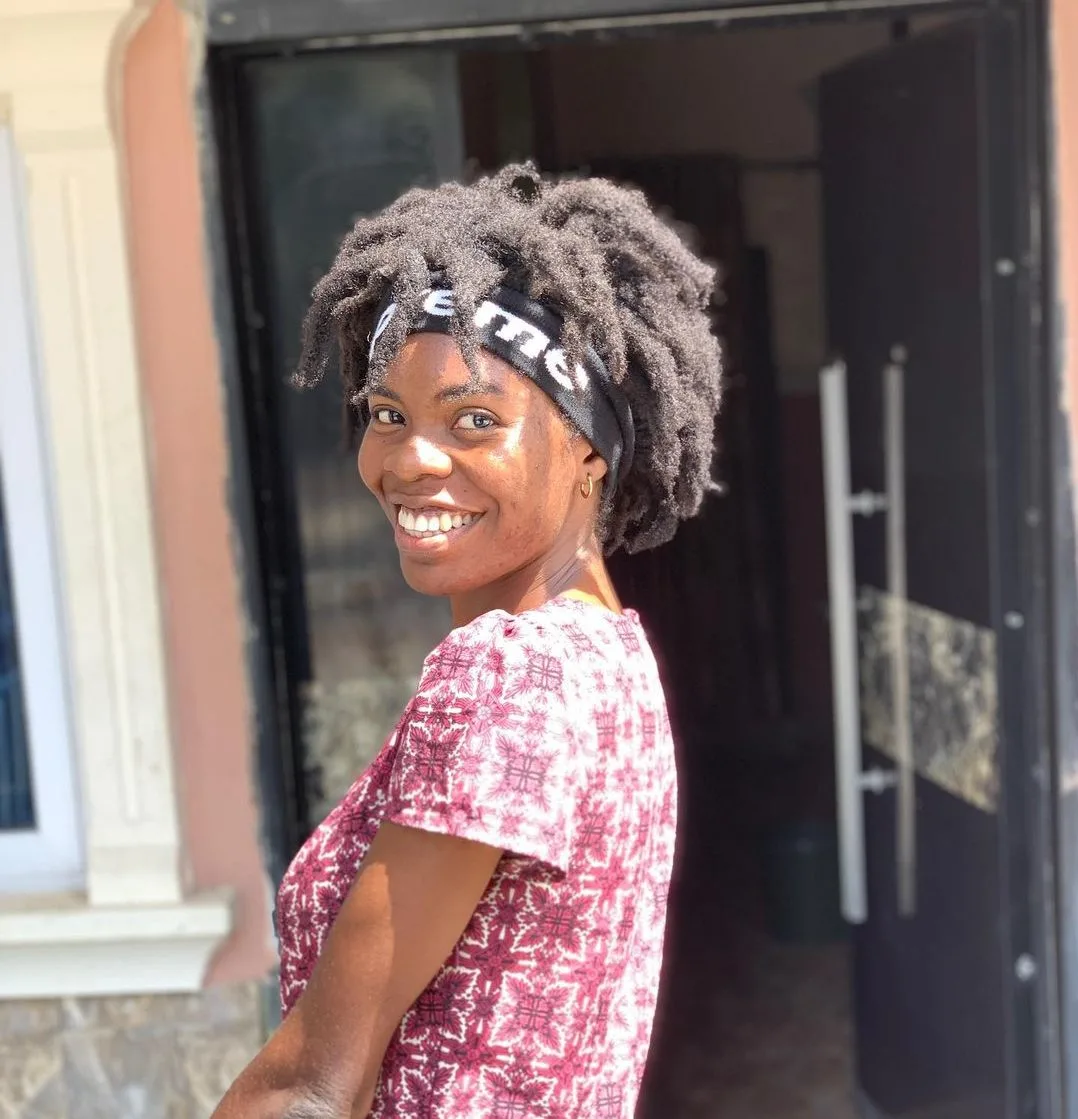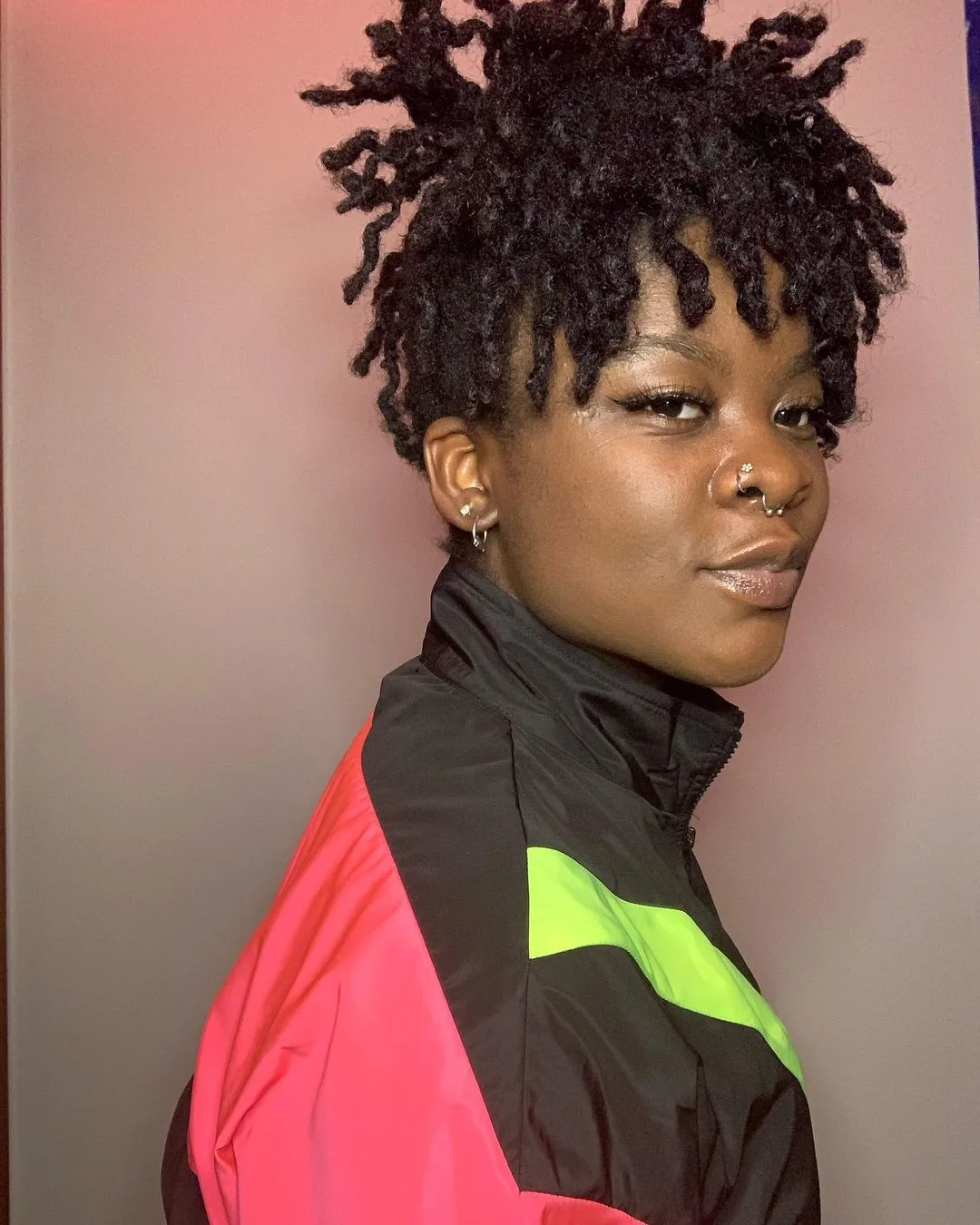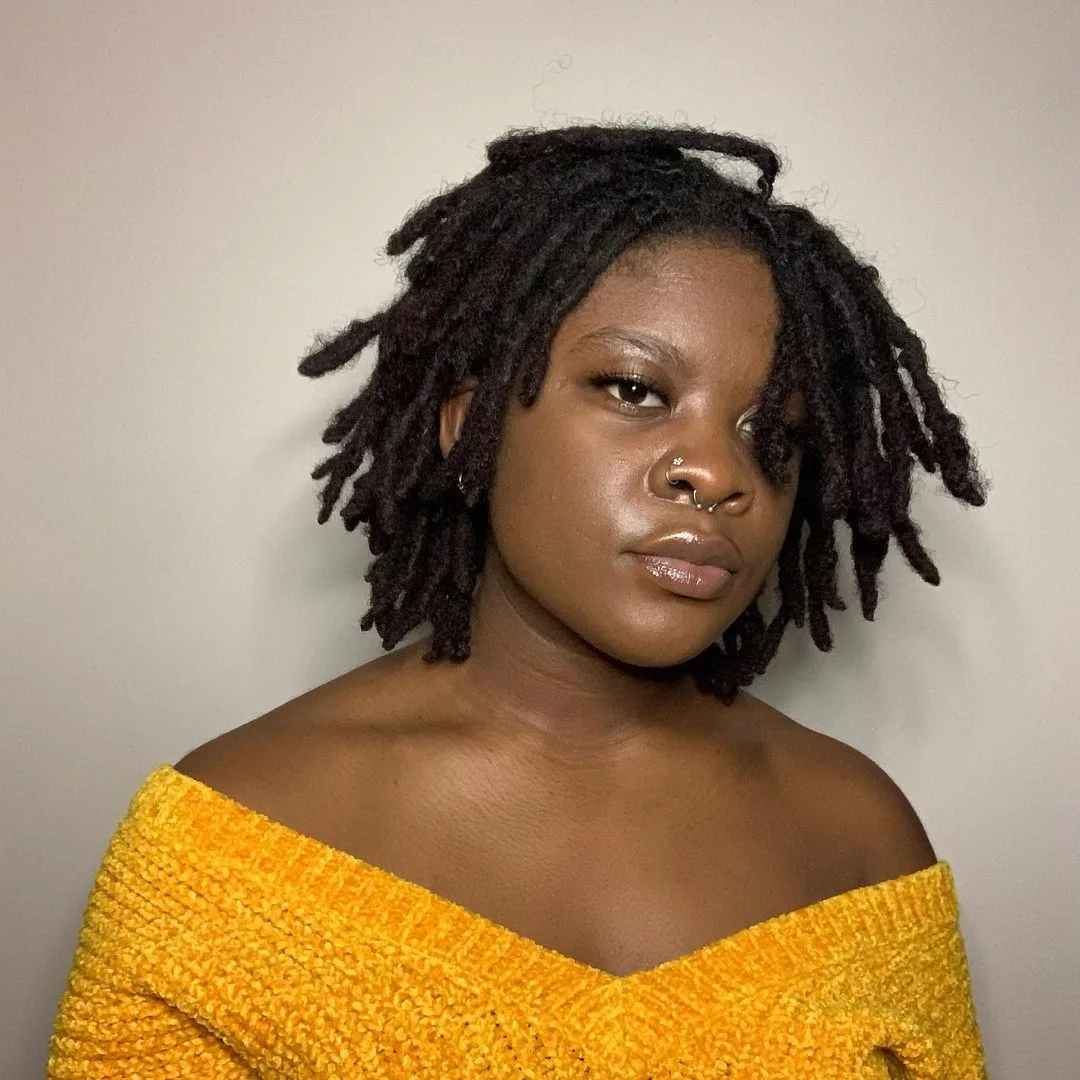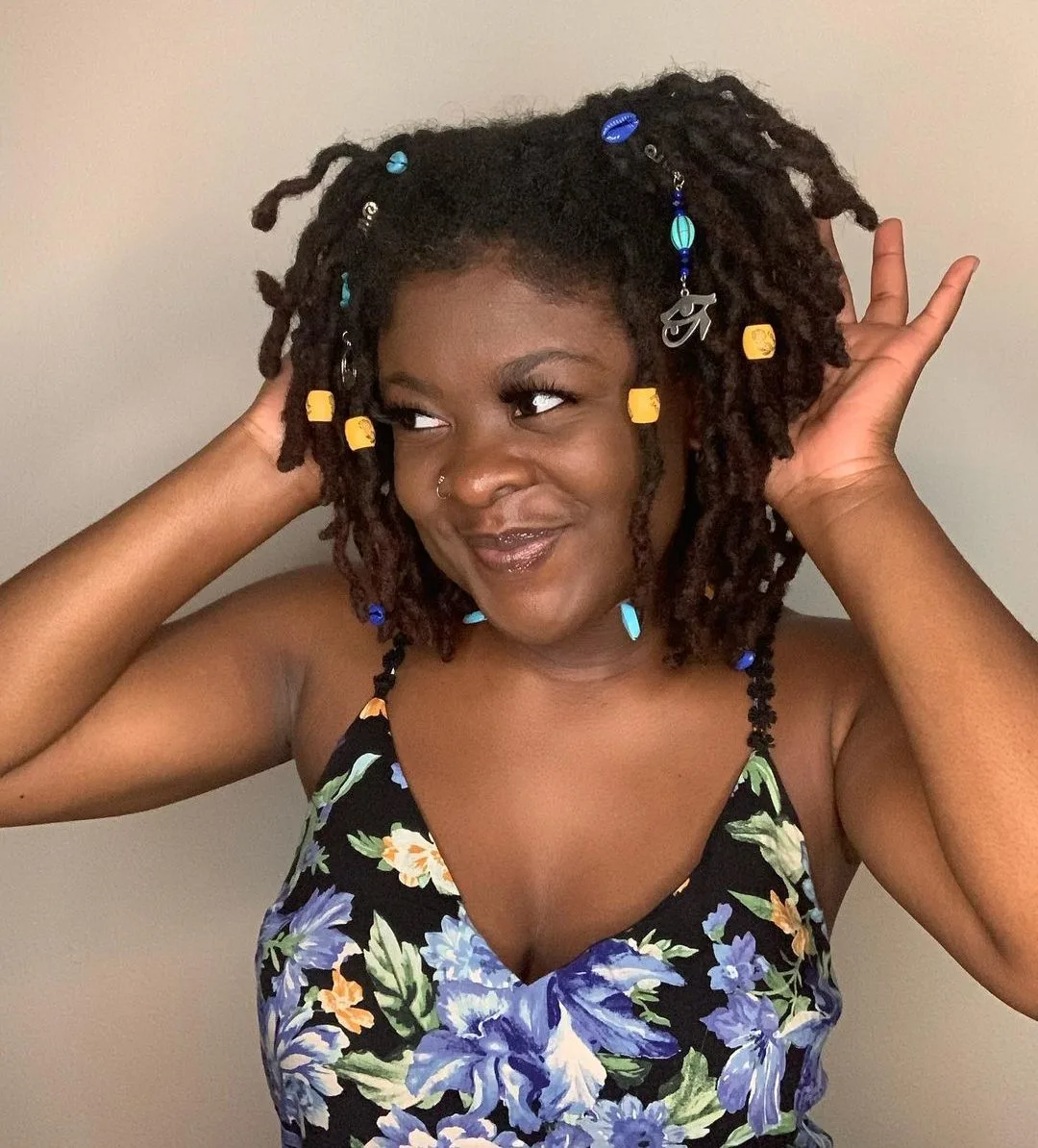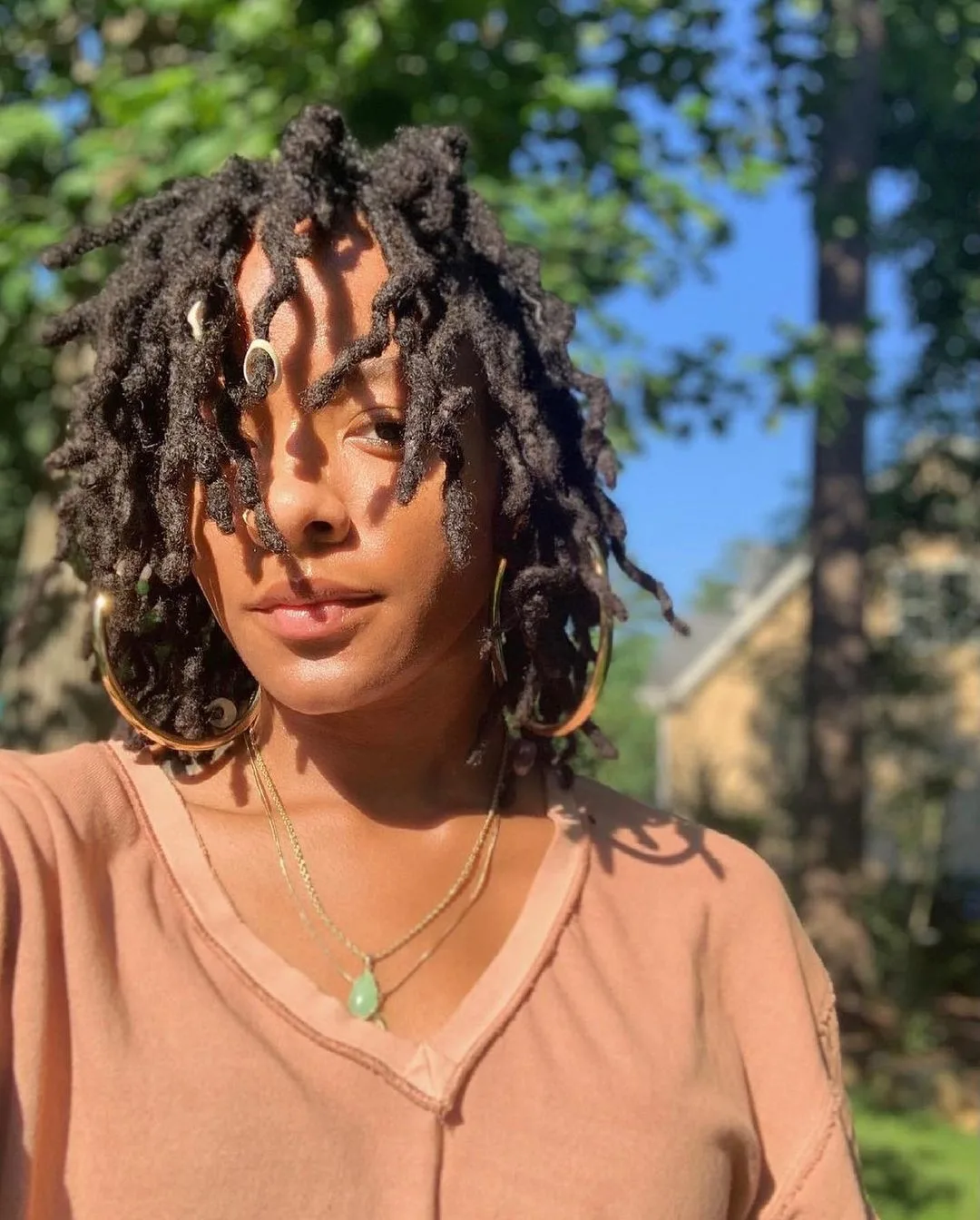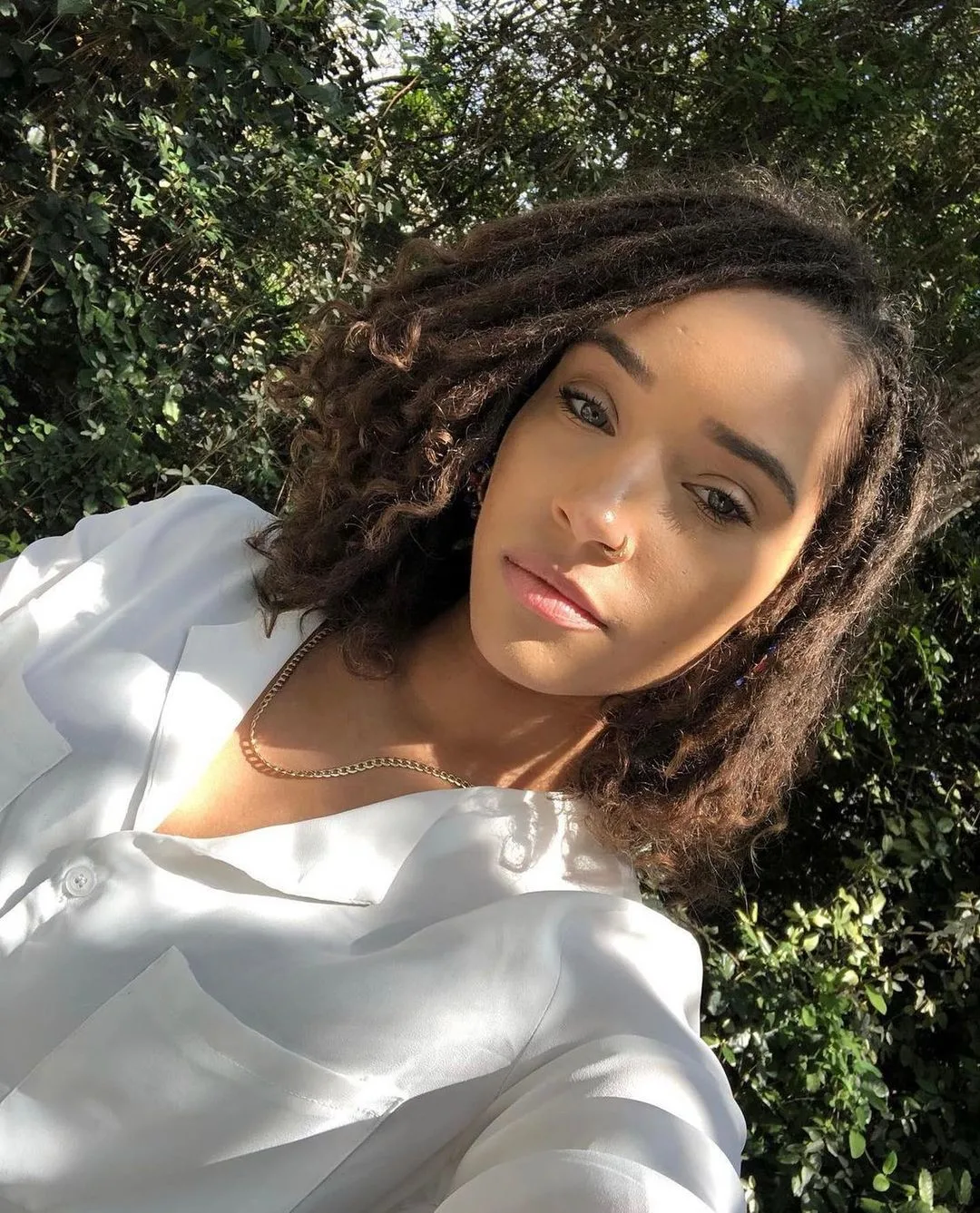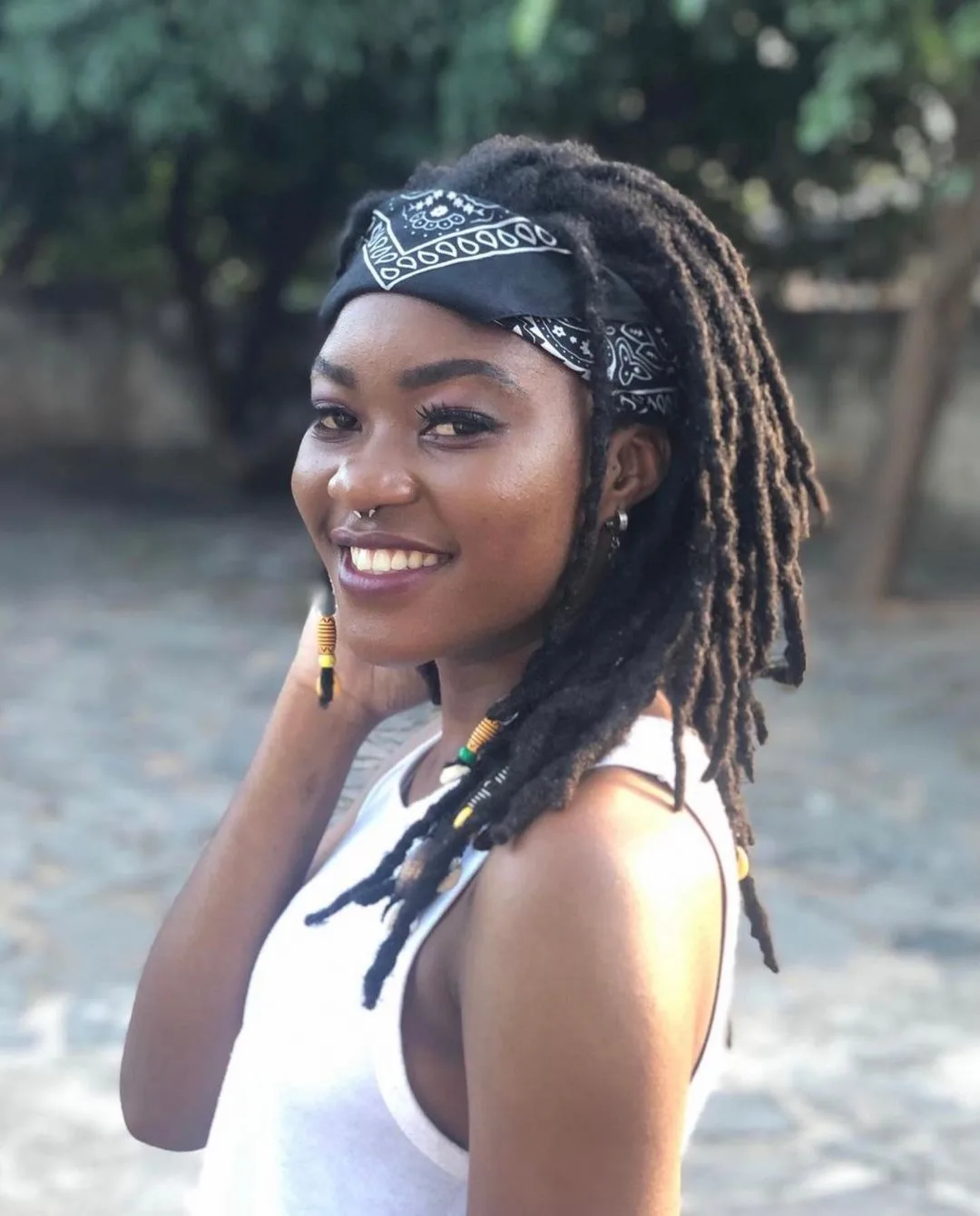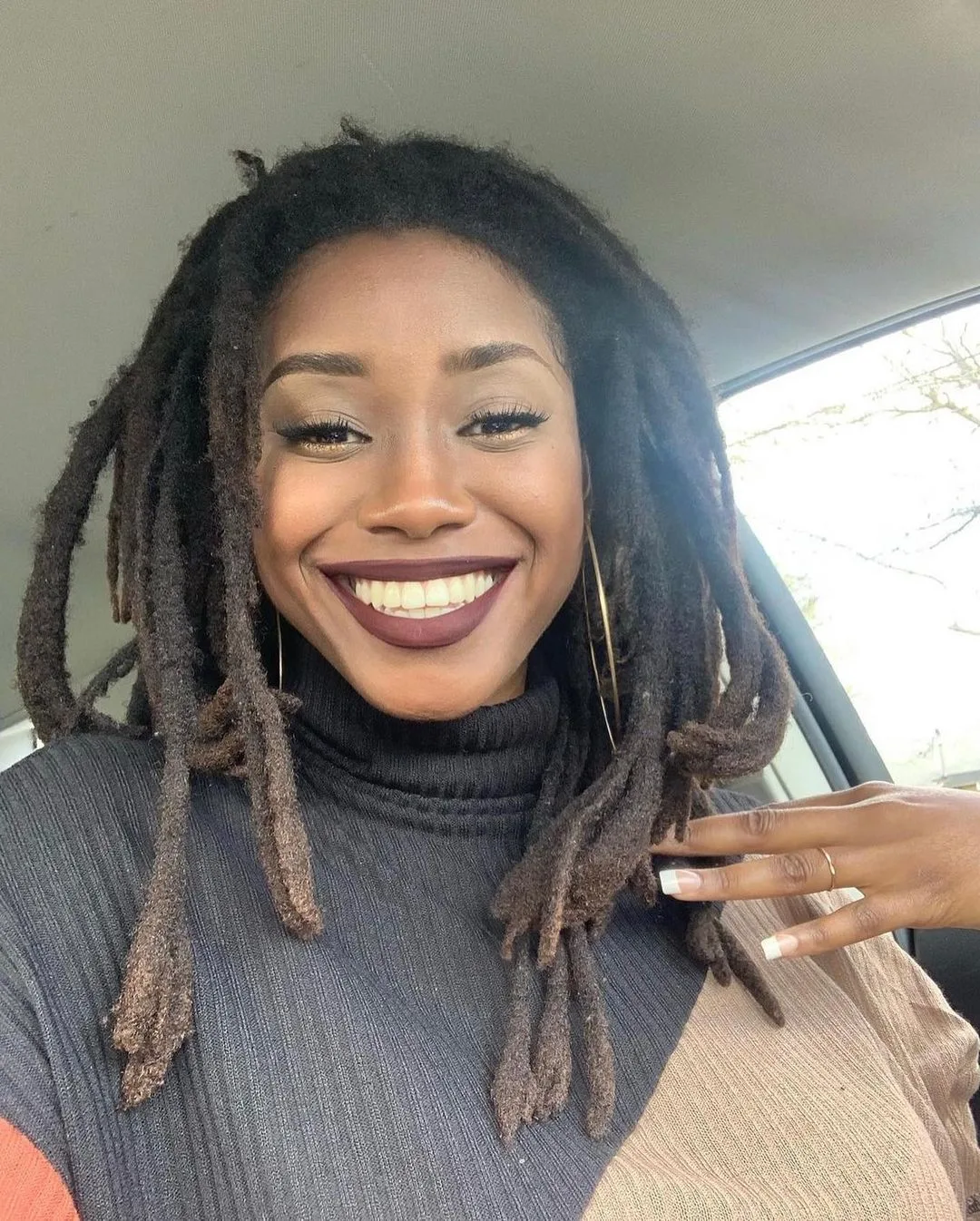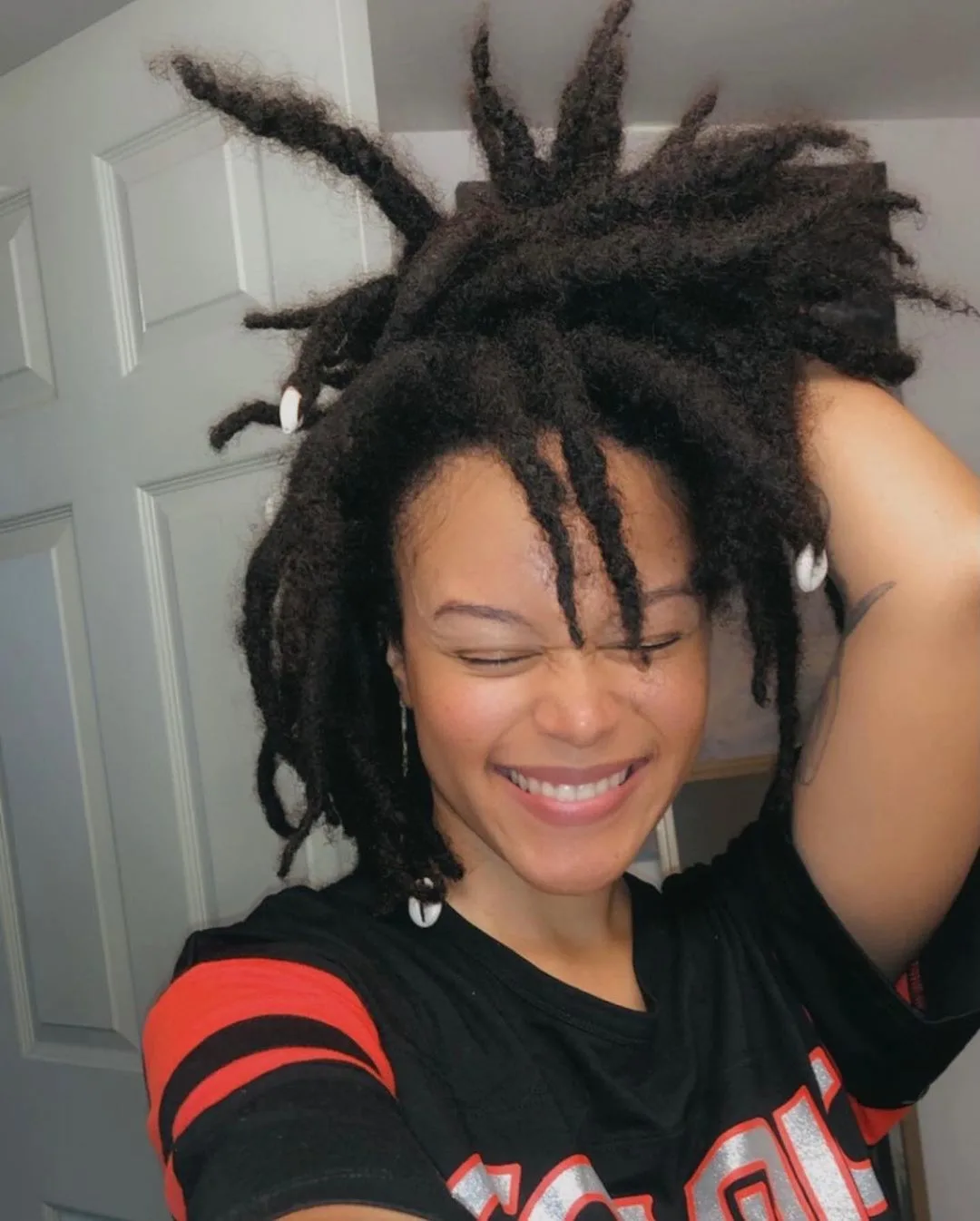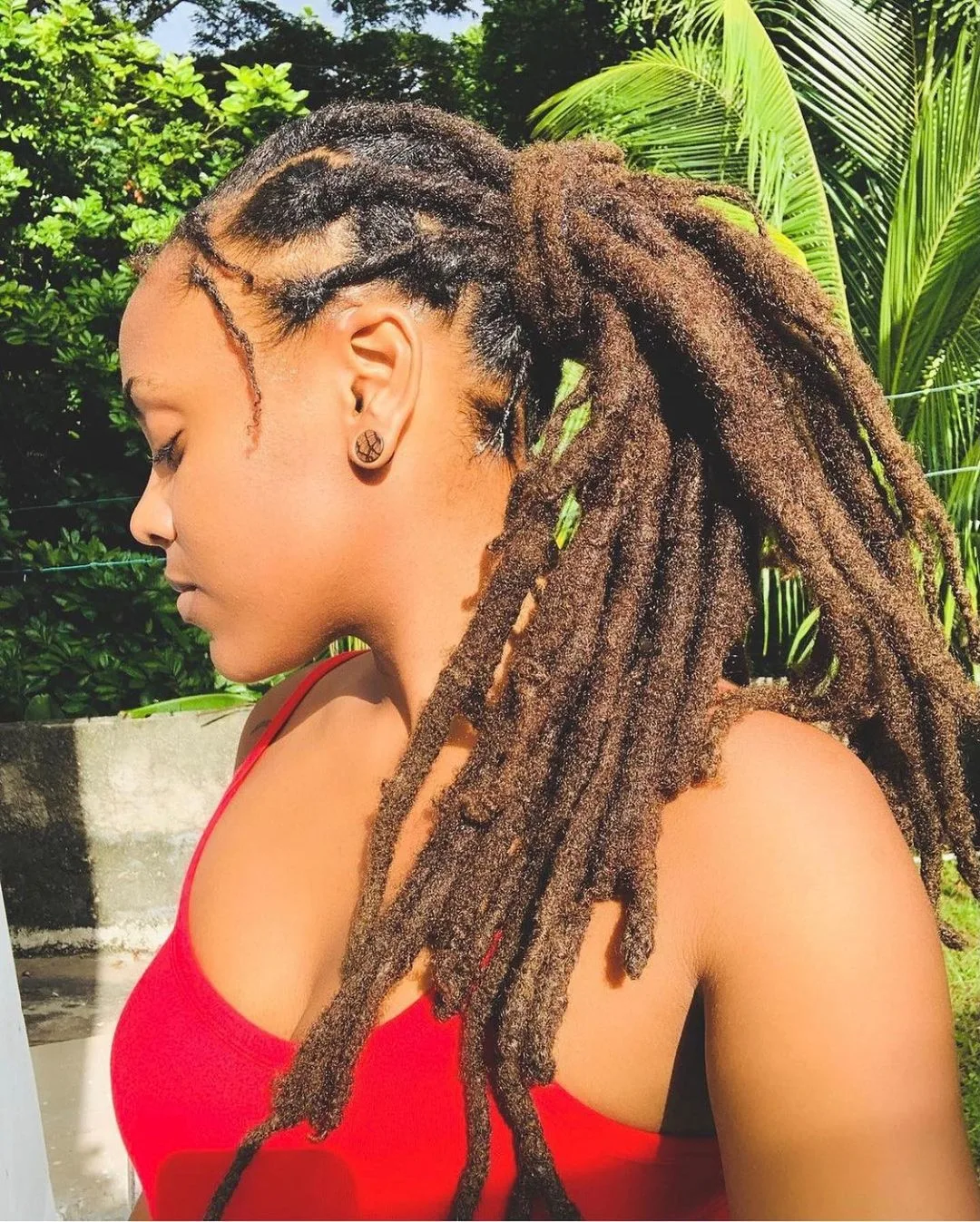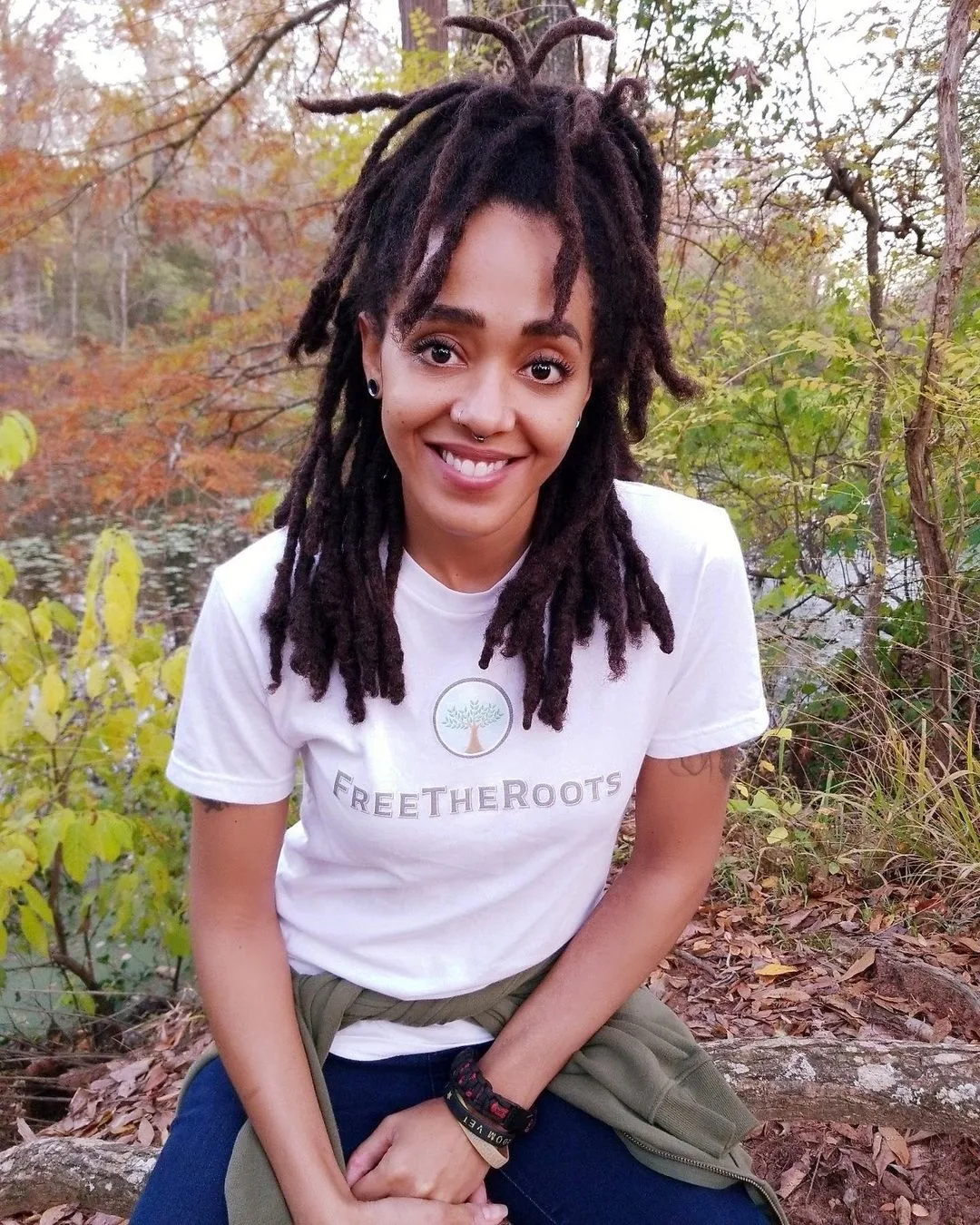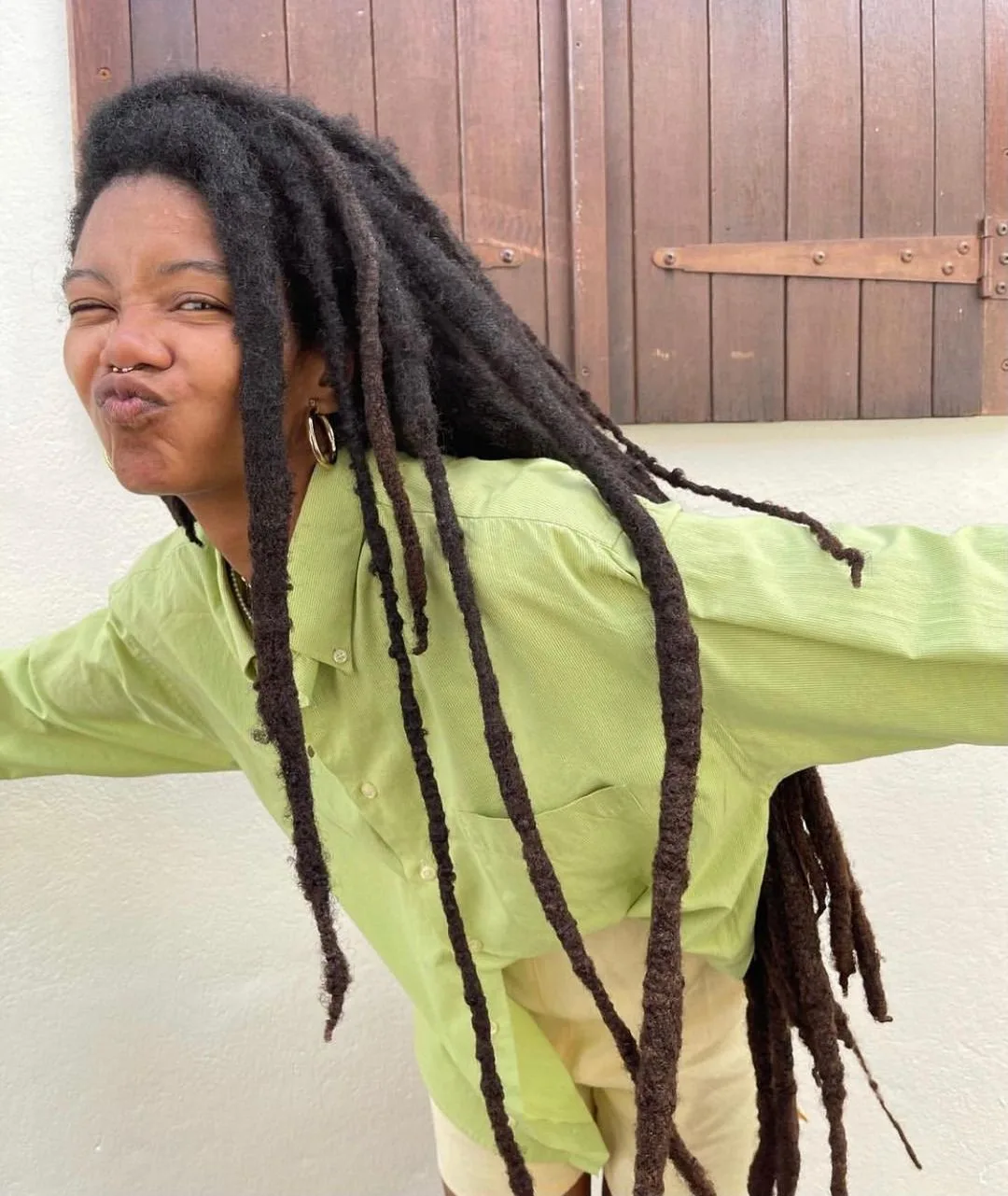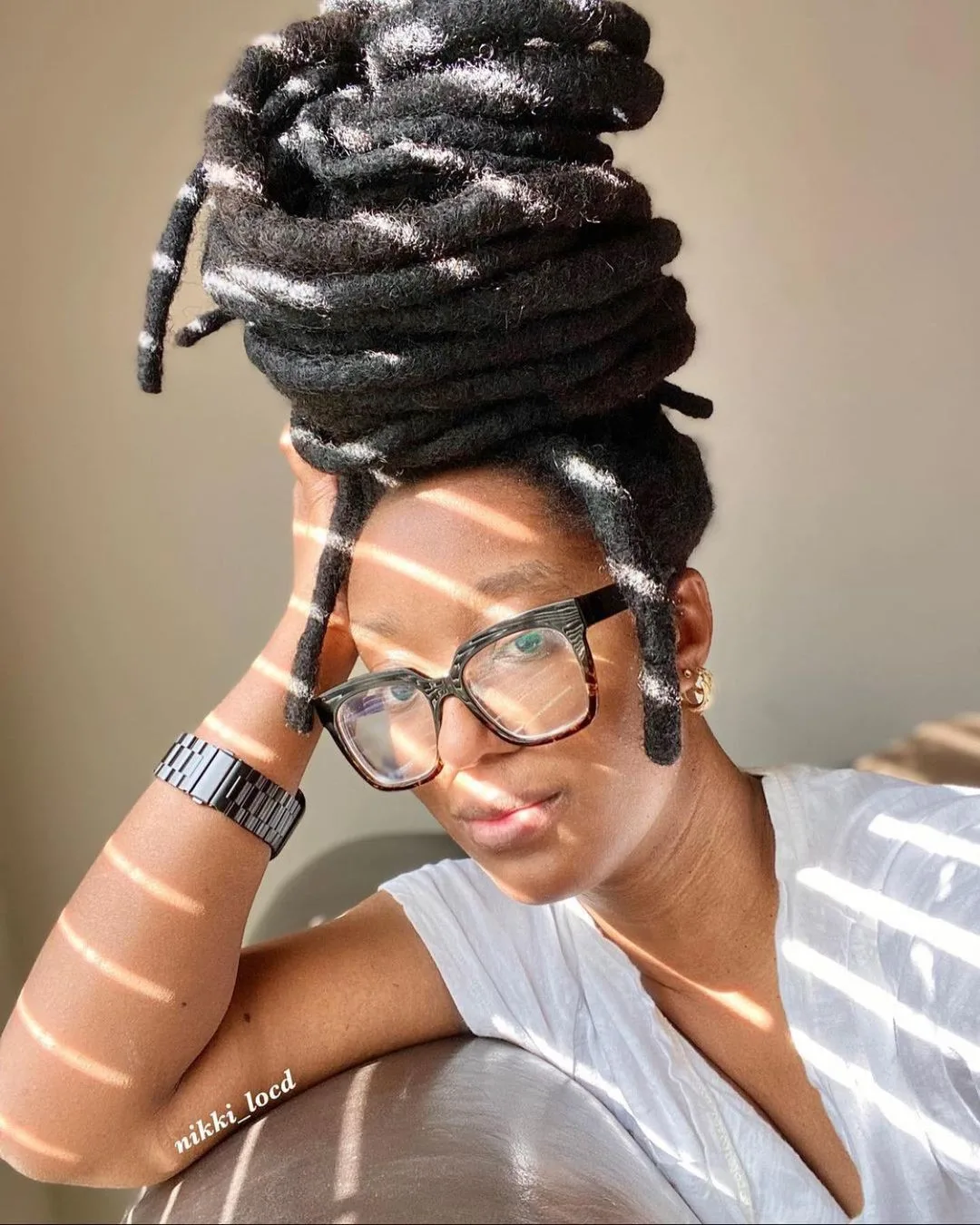Jump to:
Looking for some loc inspiration? You’re in the right place. Read on to learn about the ins and outs of freeform dreads, how to style them, pros and cons, and 30 examples to have you saying “ya mon!”
What Are Freeform Dreads?
Locs, aka dreadlocks or dreads, are strands of hair that lock together into themselves, hence the name. Locs are often thick and resemble rope, though there’s no “standard” size for them. You can go super small or extra large and anywhere in between.
There are a few popular methods used to create dreadlocks:
- Backcombing
- Twist and rip
- Braiding
- Freeform
In this article, we’ll be taking a look at freeform exclusively to get all the details on this all-natural approach. True to its name, the freeform technique consists of allowing the dreads to form freely.
Since locs are essentially tangled hair that’s knotted itself, they can form naturally by just allowing the hair to knot. There’s little to no manipulation or styling needed; the hair dreads itself over time. In contrast, “regular” locs will get retwisted or styled regularly to ensure uniformity.
Freeform locs can be started by literally doing nothing. If you have hair with a tight curl pattern, then this is a good option.
You can also start by manually braiding or twisting your hair but then leaving it alone to form freely. The method you choose to start your freeform dreads will depend on your hair type and how natural you want to go.
While leaving your hair alone is important, washing your hair is just as crucial. Dirty, oily hair won’t grow well, so it’s vital you keep your hair clean. That said, avoid using any unnecessary products like gels or waxes.
What Are Semi-Freeform Dreads?
Technically, a fully freeform style involves not doing anything to your hair besides washing it. While this natural process is an important aspect of the loc journey for many people, others want to speed up the process a bit, so they go semi-freeform.
In a nutshell, semi-freeform typically consists of retwisting locs occasionally— every 4-6 months or so —to accelerate the rate at which the hair locs. The retwisting encourages the hair to follow its pattern of growth.
Another common element of semi-freeforming is separating congos, which occur when two separate locs combine into one. If you go pure freeform, you may end up with a few congos, and this is what often contributes to the varying sizes of freeform locs.
Growing out dreadlocks is a commitment, so make sure you take all of this into account before diving in.
Of course, an article on freeform dreads wouldn’t be complete without a look at the variety of styles out there, so let’s take a look at some of the best freeform dread styles for both men and women.
Read Next: How to Start Dreadlocks
Freeform Dreads for Men
1. Classic Dreads
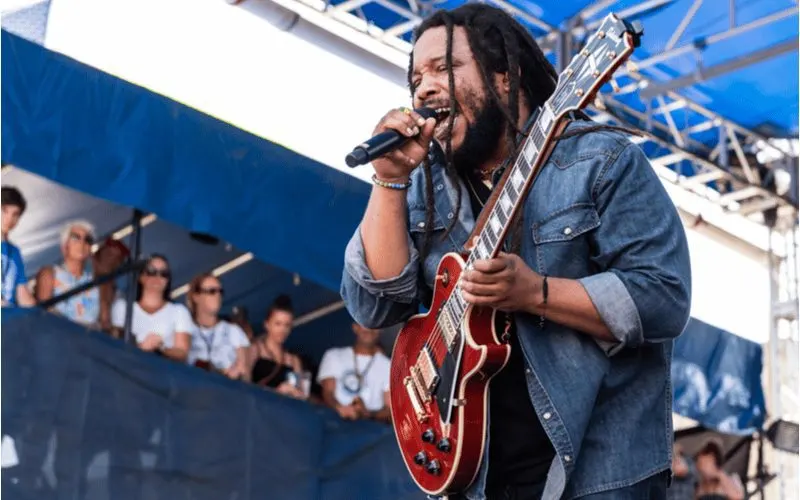
Carl Beust/Shutterstock
Few people have represented locs on a large scale more than Bob Marley did. His hairstyle is so iconic that many people automatically associate dreadlocks with him. Thankfully, his son Stephen is keeping the look alive. Just like his dad, Stephen rocks long natural dreads of varying sizes and textures.
2. Short Dreads
Curious to see what the early stages of loc growing look like? Here’s 10 months of freeform growth. The locs range in length from about 1 to 2 inches, and while they’re small, they’re not quite micro locs.
Of course, your results will vary depending on your exact hair type and how fast your hair naturally grows.
3. Shoulder Length Dreads
And to give you an idea of what the loc journey looks like down the road, here’s the same model after about 3 years of growth. The dreadlocks have fully developed into full, thick strands.
And the hair is now used to its new growth patterns. These medium-sized locs offer a nice balance of volume and manageability, and they really highlight the hair’s texture.
4. Thin Locs
If you prefer thinner locs—or if that’s just how your hair dreads itself naturally—then check out this shoulder-length thin loc style. This offers a nice contrast between the overall volume and the size of the actual locs.
This contrast creates a lot of thickness and body in the hair. This is another style that works well with tightly curled hair (think type 4c).
5. Blooming Dreads
During the first year or so of your loc journey, you may feel like you’re limited in how you can style your hair, but this is fortunately not the case. There are tons of creative ways to style shorter locs.
This wild, expansive look is just one option, and it gets a surprising amount of volume out of short, thin dreads. It also does a great job of highlighting the texture and character of the locs.
6. Long Locs
If you have the perseverance to grow your locs out for years, you’ll be rewarded with long and flowing strands. The model here is displaying an incredible 8 years of freeform growth.
While that’s a long time, the results speak for themselves. These majestic dreads look are just as cool whether you let them hang or tie them up.
7. Sparse Medium Dreads
Prefer slightly larger locs? Check out these medium freeform dreads. While they’re not huge, these dreads are on the larger side and show off the texture of the hair in a much different way. If you want looser locs, this is a compelling option.
8. Thick Dreads
Now let’s look at some thicker freeform dreads. When you’re growing your locs, your hair might naturally form thicker dreadlocks, or you may find that your hair locs into congos. Either way, thick locs are sick, so if you got ‘em, flaunt ‘em.
9. Long Tied Locs
Many people who rock freeform dreads enjoy tying them up in various ways to not only highlight the texture but also show off their growth. You can get really creative with tying up your dreads, especially if they’ve grown quite long.
10. Congos
While some freeformers want to avoid congos, others embrace them wholeheartedly to channel the Rastafarian style of locs. Depending on your hair type, this can create quite large locs and a ton of volume.
This is easily one of the most iconic loc styles, and while not everyone has the hair for them, there’s no denying they’re straight up kingly.
11. Fuzzy Locs
Here’s another loc style that works best for people with particular hair types. If your hair tends to be more coiled than kinky, then this style may be for you. When coiled hair locs, it will be noticeably fuzzier than curly or kinky hair, and you can use this to your advantage.
12. Freeform Explosion
A popular freeform style is to separate the locs, many of which are congos, and style them so they stick up and out, resulting in this “exploded” look. While you do need to move your locs around for this one, you don’t have to retwist your hair or otherwise affect it.
13. Dyed Dreads
Of course, you can also color your locs! Two-toned or tip-dyed dreads are quite popular, especially among semi-freeformers, and the color adds a startling effect that complements the hair’s texture.
14. Voluminous Freeform Dreads
Here’s another high-volume style that proves you can get a ton of body from freeform dreads. This is most easily accomplished with medium to large locs, though it’s also possible if you have lots of smaller locs.
15. Loc Goals
Last but certainly not least, feast your eyes on these amazing long dreads. While most people won’t go for this style, we absolutely had to include these beastly locs as a testament to how impressive hair can get when you just let it do its own thing.
Freeform Dreads for Women
1. Thick Locs
This hairstyle exemplifies everything great about freeform dreads. The locs are thick yet defined, and the natural growth contributes to variety in loc size that adds a ton of style.
The dreads also really show off the texture of the model’s 4c hair, which has the tightest curl pattern of any hair type and thus locs quickly and easily.
2. Fluffy Dreads
Certain types of hair will look extra fluffy when styled into locs, resulting in a headful of texture and thick dreads. The curlier or kinkier your hair is, the more you’ll see this texture once your freeform dreads start developing and filling out.
If your hair is extra curly, then your locs may even expand and become thicker as they grow. As we said above, it really just depends on how thick your hair is to begin with.
3. Textured Freeform Dreads
Freeform dreads are naturally textured, but depending on your hair type and other factors like the size of your locs, they may turn out extra textured.
You can instantly see the glorious texture of these thick and fluffy locs, and it gives an extra bit of sparkle to the overall style. Make sure your locs don’t get frizzy and out of control, and you’ll be rewarded with amazing texture.
4. Crimped Locs
It’s common to see long locs that go down to the shoulders (or past them), but there are many cool options for short locs, too. Check out this high-volume look that’s full of texture and displays the power of the locs.
To get this style, you’ll need shorter locs that are medium thickness. By crimping or curling the locs, you can get a good amount of volume and lift, plus a little bit of extra texture.
5. Medium Freeform Dreads
Looking for some stylish yet straightforward locs? You can’t go wrong with a medium loc look. Going with a medium thickness lets you show off the texture of your locs, and you might prefer the size if you want something bigger than thin locs but don’t want anything huge.
6. Bejeweled Locs
Styling your locs isn’t the only way to have fun with them—you can also accessorize! Many women add jewelry, beads, and even shells and stones to their locs for a unique, eye-catching twist.
An added bonus is that accessorizing allows you to express yourself through your hair even more.
7. Tight Freeform Dreads
For those of you with naturally smaller or tighter locs, check out this style. Small and dense dreads look just as cool as huge congos, and they have their own personality that really shines through.
8. Curly Ends
When you’re starting your freeform or semi-freeform journey, you may find that the tips of your locs curl or become wavy. The curls will go away over time, but if you like them, you can keep them by combing out the ends of your locs after each wash.
9. Flowing Dreads
Another simple yet powerful look, this relaxed freeform style is easy to love. Slap on a bandana and/or some jewelry, and you’ve got an eye-catching hairstyle that displays your locs in full force.
10. Matted Dreads
While all dreadlocks will mat, some locs will mat faster and more severely than others. Most of the time, this isn’t something you need to fix, even if your hair is on the more matted side. Instead, you can rock the texture!
11. Spiky Dreads
Your dreads might also turn out large and spiky, going off in all kinds of directions and adding a ton of personality to your hair. It’s always fun to tousle your locs and try different styling possibilities.
12. Ponytail
Here’s another tying option that involves using your locs to tie themselves into a ponytail. Basically, some of your locs are being used as the scrunchie, which is pretty cool.
13. Locs With Length
After some serious length all over? You might want to try growing out the locs on top of your head. While the locs on top are usually shorter, they can also get super long, which makes for a very tall hairstyle.
14. Extreme Locs
Here’s another look at how crazy locs can get when grown out. These locs practically reach the knees! To say they’re impressive is definitely an understatement.
15. Coil Queen
Do we really need to say more? If your freeform dreads get to be this insane, then you can basically do whatever you want with them.
Pros of Freeform Dreads
Lots of dreadheads like the freeform approach because it’s simple and natural. You don’t need to use any hair product, so you don’t need to worry about any gels or waxes building up in your hair. It’s also foolproof because, well, you don’t really do anything.
Many people choose to grow out dreads for spiritual reasons, and the freeform approach is often the method of choice because it’s completely natural. Aside from washing your hair, you don’t need to apply anything to your locs.
Cons of Freeform Dreads
Of course, with such a simple method comes a couple of trade-offs. Perhaps the biggest disadvantage of freeform dreads is the time required to grow them. Because the hair develops naturally, you can’t rush it, so it often takes several months to fully grow out.
Usually, it’ll be 3-6 months before you start seeing real progress, but it can take up to 2 years for the locs to fully develop. Hair type is critical here—the curlier your hair is, the faster it will loc, but it’s still a long-term process.
That said, many dreadheads enjoy the journey of growing it out.
The other potential con is that your hair may not loc perfectly. Since the process is 100% natural, your hair may behave in unexpected ways. If this happens, you’ll have to tidy up your locs to ensure there are no stray hairs or messy strands.
Also, freeform locs may not all be the same size, but most people who choose the freeform method embrace this. If uniformity of size is important to you, then you may be better off choosing another method.
Frequently Asked Questions
How long do freeform dreads take?
While it'll typically take about three to five weeks to start your freeform dreads, it might take longer, as everyone's hair is different. The actual timeline will also depending on how long you want them. On average, freeform dreads take between six and twelve months to fully grow.
What are freeform dreads?
Freeform dreads are a type of dreadlock that form naturally without any manipulation at the beginning. They're made using natural products to jumpstart the process, and are the most natural type of dreadlock.
Can anyone get freeform dreads?
Yes. Anyone can grow freeform dreads, with or without the use of gels and waxes. Because they grow naturally, all you need to do is let your hair grow into itself, creating the natural dreadlock.
Can freeform dreads be undone?
Yes, freeform dreads can be undone. However, the dread is achieved by letting your hair naturally become matted and tangled, so it'll be extremely hard to break them up. But, with enough persistence, it can be done.
Can hair dread itself?
While clean hair will dread itself, it will take some time. Some experts say this will happen in as little as 5 weeks, the reality is that you'll have Marley-like locs at closer to a year.
Should You Get Freeform Dreads?
Freeform dreads are unique and bear a rich cultural history. People get them for different reasons, but ultimately, growing out locs is about embracing your natural hair.
Growing out freeform dreads will take a long time, but if you appreciate the process, then the loc journey might be right for you.
No matter what your hair type is, you’ll be able to get locs, but it helps if your hair is curly, coiled, or kinky. What you really need, though, is patience.
If you do decide to start your loc journey, make sure you follow proper hygiene. Wash your hair regularly and avoid any products that aren’t shampoo, and maybe even condition it.
Most importantly, enjoy the ride. Are you planning on growing out freeform dreads? Got any questions about locs? Be sure to let us know!

